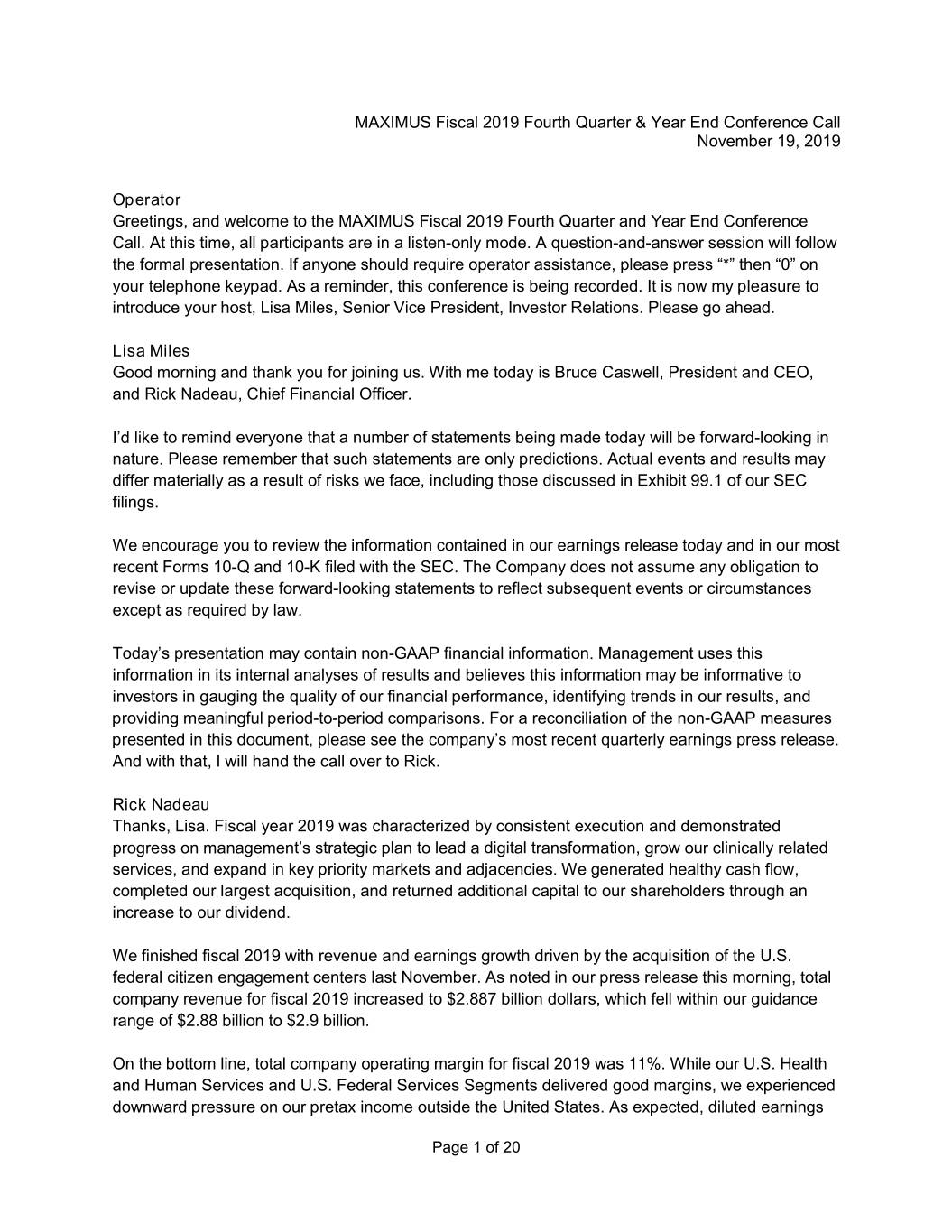
MAXIMUS Fiscal 2019 Fourth Quarter & Year End Conference Call November 19, 2019 Operator Greetings, and welcome to the MAXIMUS Fiscal 2019 Fourth Quarter and Year End Conference Call. At this time, all participants are in a listen-only mode. A question-and-answer session will follow the formal presentation. If anyone should require operator assistance, please press “*” then “0” on your telephone keypad. As a reminder, this conference is being recorded. It is now my pleasure to introduce your host, Lisa Miles, Senior Vice President, Investor Relations. Please go ahead. Lisa Miles Good morning and thank you for joining us. With me today is Bruce Caswell, President and CEO, and Rick Nadeau, Chief Financial Officer. I’d like to remind everyone that a number of statements being made today will be forward-looking in nature. Please remember that such statements are only predictions. Actual events and results may differ materially as a result of risks we face, including those discussed in Exhibit 99.1 of our SEC filings. We encourage you to review the information contained in our earnings release today and in our most recent Forms 10-Q and 10-K filed with the SEC. The Company does not assume any obligation to revise or update these forward-looking statements to reflect subsequent events or circumstances except as required by law. Today’s presentation may contain non-GAAP financial information. Management uses this information in its internal analyses of results and believes this information may be informative to investors in gauging the quality of our financial performance, identifying trends in our results, and providing meaningful period-to-period comparisons. For a reconciliation of the non-GAAP measures presented in this document, please see the company’s most recent quarterly earnings press release. And with that, I will hand the call over to Rick. Rick Nadeau Thanks, Lisa. Fiscal year 2019 was characterized by consistent execution and demonstrated progress on management’s strategic plan to lead a digital transformation, grow our clinically related services, and expand in key priority markets and adjacencies. We generated healthy cash flow, completed our largest acquisition, and returned additional capital to our shareholders through an increase to our dividend. We finished fiscal 2019 with revenue and earnings growth driven by the acquisition of the U.S. federal citizen engagement centers last November. As noted in our press release this morning, total company revenue for fiscal 2019 increased to $2.887 billion dollars, which fell within our guidance range of $2.88 billion to $2.9 billion. On the bottom line, total company operating margin for fiscal 2019 was 11%. While our U.S. Health and Human Services and U.S. Federal Services Segments delivered good margins, we experienced downward pressure on our pretax income outside the United States. As expected, diluted earnings Page 1 of 20
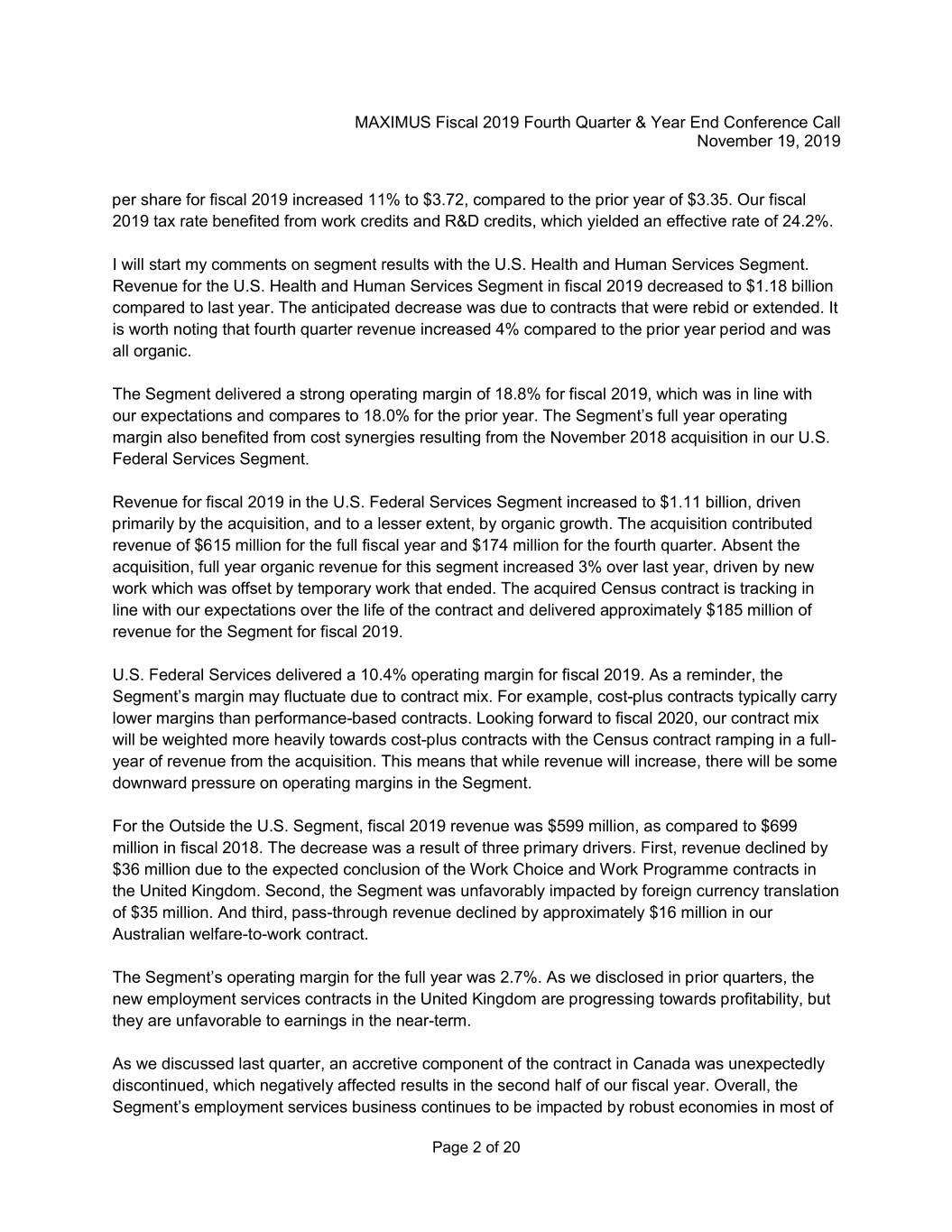
MAXIMUS Fiscal 2019 Fourth Quarter & Year End Conference Call November 19, 2019 per share for fiscal 2019 increased 11% to $3.72, compared to the prior year of $3.35. Our fiscal 2019 tax rate benefited from work credits and R&D credits, which yielded an effective rate of 24.2%. I will start my comments on segment results with the U.S. Health and Human Services Segment. Revenue for the U.S. Health and Human Services Segment in fiscal 2019 decreased to $1.18 billion compared to last year. The anticipated decrease was due to contracts that were rebid or extended. It is worth noting that fourth quarter revenue increased 4% compared to the prior year period and was all organic. The Segment delivered a strong operating margin of 18.8% for fiscal 2019, which was in line with our expectations and compares to 18.0% for the prior year. The Segment’s full year operating margin also benefited from cost synergies resulting from the November 2018 acquisition in our U.S. Federal Services Segment. Revenue for fiscal 2019 in the U.S. Federal Services Segment increased to $1.11 billion, driven primarily by the acquisition, and to a lesser extent, by organic growth. The acquisition contributed revenue of $615 million for the full fiscal year and $174 million for the fourth quarter. Absent the acquisition, full year organic revenue for this segment increased 3% over last year, driven by new work which was offset by temporary work that ended. The acquired Census contract is tracking in line with our expectations over the life of the contract and delivered approximately $185 million of revenue for the Segment for fiscal 2019. U.S. Federal Services delivered a 10.4% operating margin for fiscal 2019. As a reminder, the Segment’s margin may fluctuate due to contract mix. For example, cost-plus contracts typically carry lower margins than performance-based contracts. Looking forward to fiscal 2020, our contract mix will be weighted more heavily towards cost-plus contracts with the Census contract ramping in a full- year of revenue from the acquisition. This means that while revenue will increase, there will be some downward pressure on operating margins in the Segment. For the Outside the U.S. Segment, fiscal 2019 revenue was $599 million, as compared to $699 million in fiscal 2018. The decrease was a result of three primary drivers. First, revenue declined by $36 million due to the expected conclusion of the Work Choice and Work Programme contracts in the United Kingdom. Second, the Segment was unfavorably impacted by foreign currency translation of $35 million. And third, pass-through revenue declined by approximately $16 million in our Australian welfare-to-work contract. The Segment’s operating margin for the full year was 2.7%. As we disclosed in prior quarters, the new employment services contracts in the United Kingdom are progressing towards profitability, but they are unfavorable to earnings in the near-term. As we discussed last quarter, an accretive component of the contract in Canada was unexpectedly discontinued, which negatively affected results in the second half of our fiscal year. Overall, the Segment’s employment services business continues to be impacted by robust economies in most of Page 2 of 20
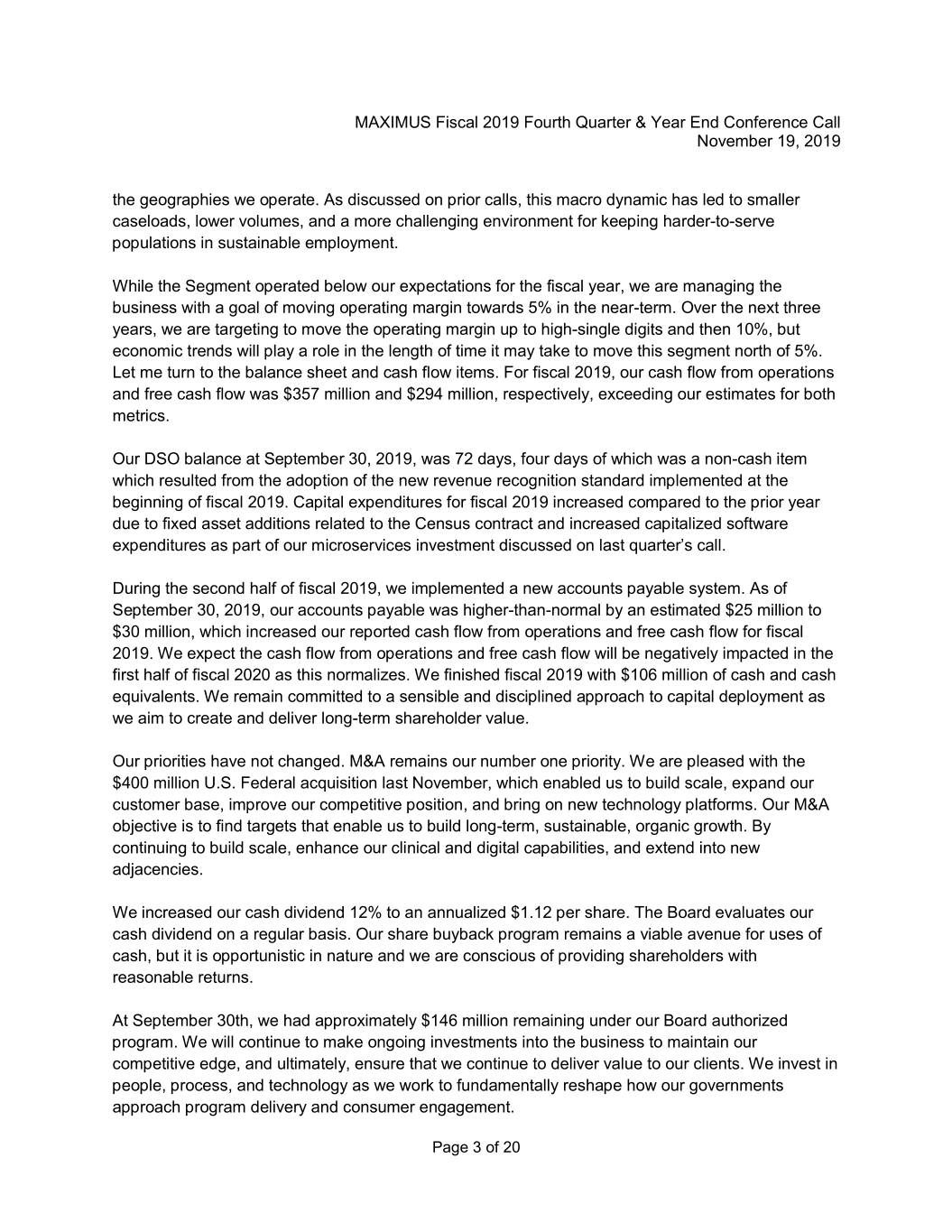
MAXIMUS Fiscal 2019 Fourth Quarter & Year End Conference Call November 19, 2019 the geographies we operate. As discussed on prior calls, this macro dynamic has led to smaller caseloads, lower volumes, and a more challenging environment for keeping harder-to-serve populations in sustainable employment. While the Segment operated below our expectations for the fiscal year, we are managing the business with a goal of moving operating margin towards 5% in the near-term. Over the next three years, we are targeting to move the operating margin up to high-single digits and then 10%, but economic trends will play a role in the length of time it may take to move this segment north of 5%. Let me turn to the balance sheet and cash flow items. For fiscal 2019, our cash flow from operations and free cash flow was $357 million and $294 million, respectively, exceeding our estimates for both metrics. Our DSO balance at September 30, 2019, was 72 days, four days of which was a non-cash item which resulted from the adoption of the new revenue recognition standard implemented at the beginning of fiscal 2019. Capital expenditures for fiscal 2019 increased compared to the prior year due to fixed asset additions related to the Census contract and increased capitalized software expenditures as part of our microservices investment discussed on last quarter’s call. During the second half of fiscal 2019, we implemented a new accounts payable system. As of September 30, 2019, our accounts payable was higher-than-normal by an estimated $25 million to $30 million, which increased our reported cash flow from operations and free cash flow for fiscal 2019. We expect the cash flow from operations and free cash flow will be negatively impacted in the first half of fiscal 2020 as this normalizes. We finished fiscal 2019 with $106 million of cash and cash equivalents. We remain committed to a sensible and disciplined approach to capital deployment as we aim to create and deliver long-term shareholder value. Our priorities have not changed. M&A remains our number one priority. We are pleased with the $400 million U.S. Federal acquisition last November, which enabled us to build scale, expand our customer base, improve our competitive position, and bring on new technology platforms. Our M&A objective is to find targets that enable us to build long-term, sustainable, organic growth. By continuing to build scale, enhance our clinical and digital capabilities, and extend into new adjacencies. We increased our cash dividend 12% to an annualized $1.12 per share. The Board evaluates our cash dividend on a regular basis. Our share buyback program remains a viable avenue for uses of cash, but it is opportunistic in nature and we are conscious of providing shareholders with reasonable returns. At September 30th, we had approximately $146 million remaining under our Board authorized program. We will continue to make ongoing investments into the business to maintain our competitive edge, and ultimately, ensure that we continue to deliver value to our clients. We invest in people, process, and technology as we work to fundamentally reshape how our governments approach program delivery and consumer engagement. Page 3 of 20
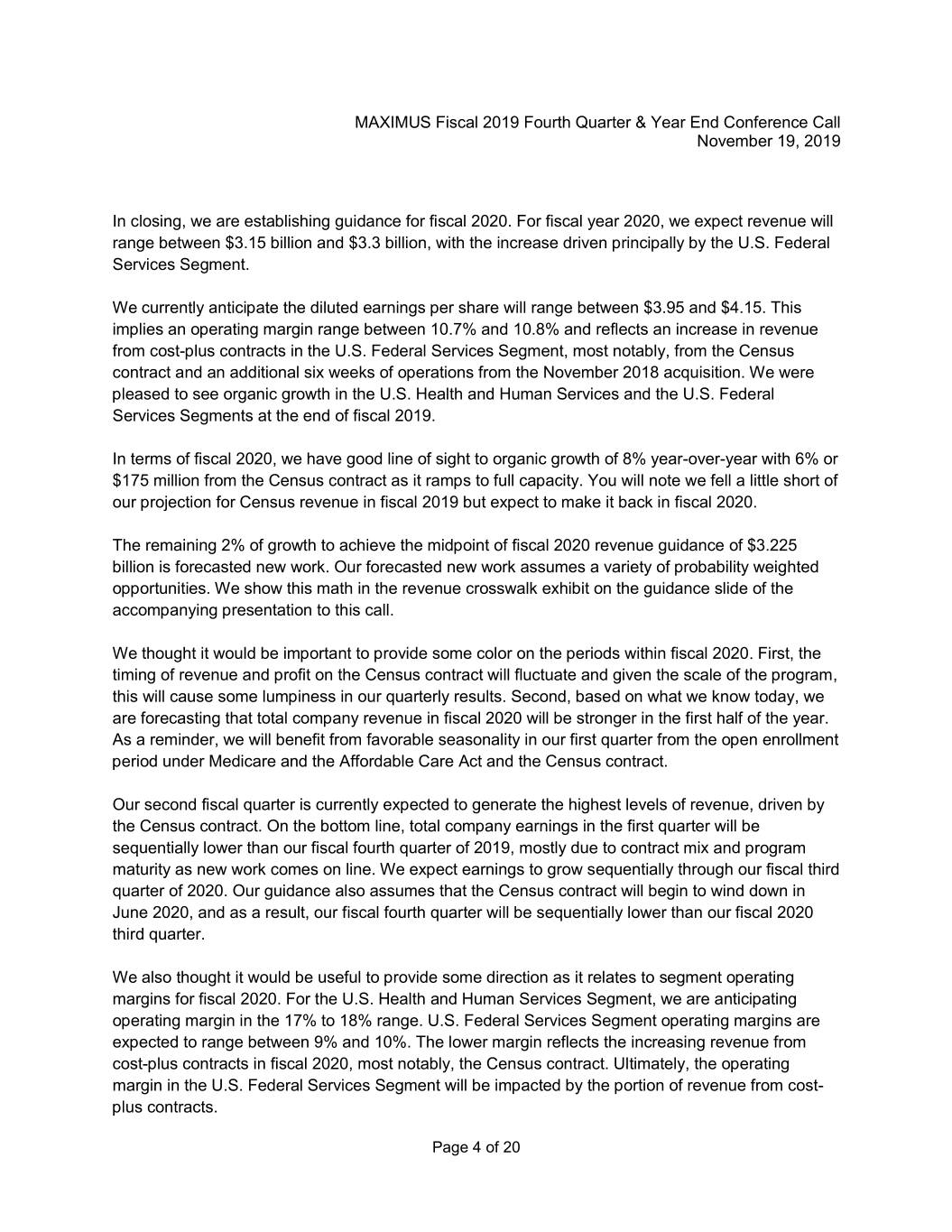
MAXIMUS Fiscal 2019 Fourth Quarter & Year End Conference Call November 19, 2019 In closing, we are establishing guidance for fiscal 2020. For fiscal year 2020, we expect revenue will range between $3.15 billion and $3.3 billion, with the increase driven principally by the U.S. Federal Services Segment. We currently anticipate the diluted earnings per share will range between $3.95 and $4.15. This implies an operating margin range between 10.7% and 10.8% and reflects an increase in revenue from cost-plus contracts in the U.S. Federal Services Segment, most notably, from the Census contract and an additional six weeks of operations from the November 2018 acquisition. We were pleased to see organic growth in the U.S. Health and Human Services and the U.S. Federal Services Segments at the end of fiscal 2019. In terms of fiscal 2020, we have good line of sight to organic growth of 8% year-over-year with 6% or $175 million from the Census contract as it ramps to full capacity. You will note we fell a little short of our projection for Census revenue in fiscal 2019 but expect to make it back in fiscal 2020. The remaining 2% of growth to achieve the midpoint of fiscal 2020 revenue guidance of $3.225 billion is forecasted new work. Our forecasted new work assumes a variety of probability weighted opportunities. We show this math in the revenue crosswalk exhibit on the guidance slide of the accompanying presentation to this call. We thought it would be important to provide some color on the periods within fiscal 2020. First, the timing of revenue and profit on the Census contract will fluctuate and given the scale of the program, this will cause some lumpiness in our quarterly results. Second, based on what we know today, we are forecasting that total company revenue in fiscal 2020 will be stronger in the first half of the year. As a reminder, we will benefit from favorable seasonality in our first quarter from the open enrollment period under Medicare and the Affordable Care Act and the Census contract. Our second fiscal quarter is currently expected to generate the highest levels of revenue, driven by the Census contract. On the bottom line, total company earnings in the first quarter will be sequentially lower than our fiscal fourth quarter of 2019, mostly due to contract mix and program maturity as new work comes on line. We expect earnings to grow sequentially through our fiscal third quarter of 2020. Our guidance also assumes that the Census contract will begin to wind down in June 2020, and as a result, our fiscal fourth quarter will be sequentially lower than our fiscal 2020 third quarter. We also thought it would be useful to provide some direction as it relates to segment operating margins for fiscal 2020. For the U.S. Health and Human Services Segment, we are anticipating operating margin in the 17% to 18% range. U.S. Federal Services Segment operating margins are expected to range between 9% and 10%. The lower margin reflects the increasing revenue from cost-plus contracts in fiscal 2020, most notably, the Census contract. Ultimately, the operating margin in the U.S. Federal Services Segment will be impacted by the portion of revenue from cost- plus contracts. Page 4 of 20
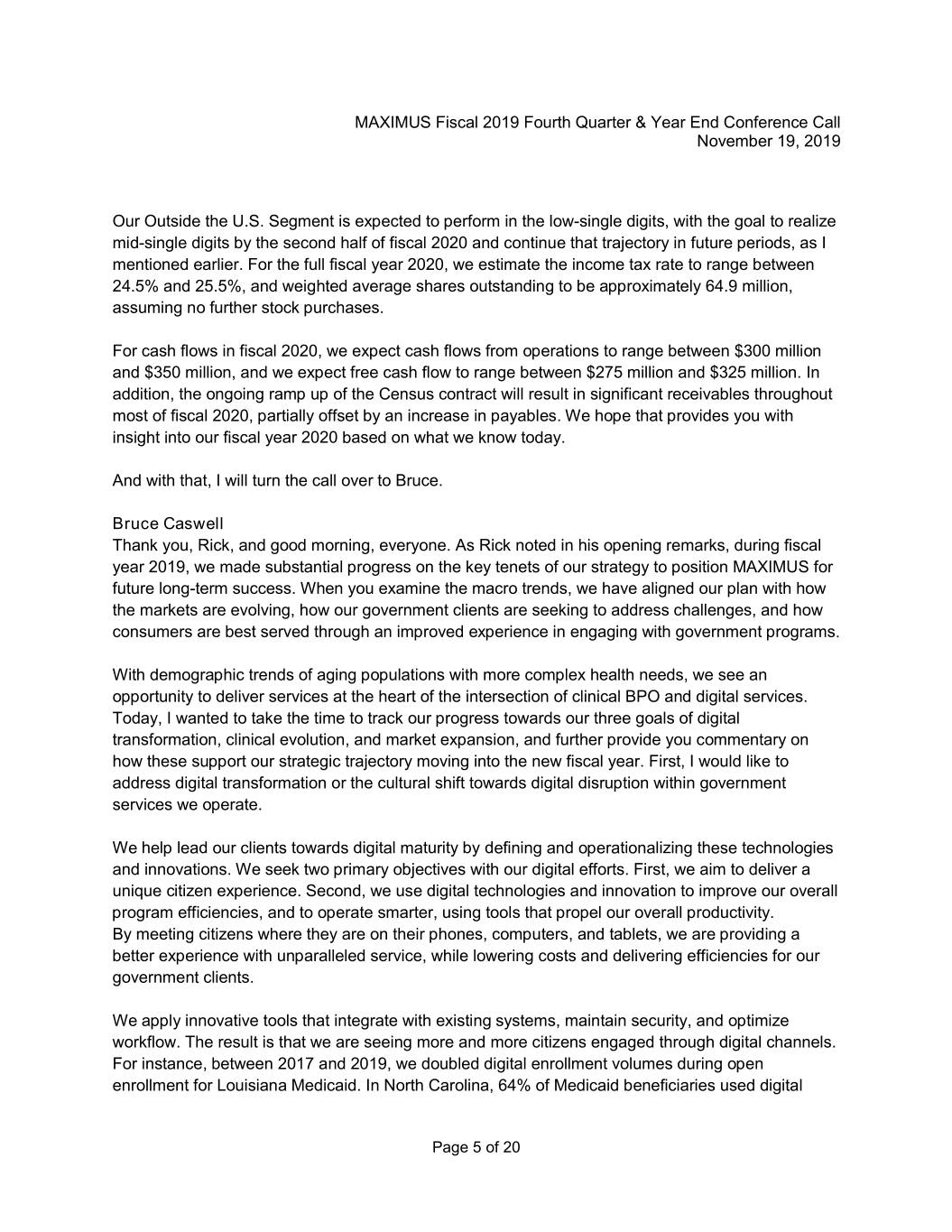
MAXIMUS Fiscal 2019 Fourth Quarter & Year End Conference Call November 19, 2019 Our Outside the U.S. Segment is expected to perform in the low-single digits, with the goal to realize mid-single digits by the second half of fiscal 2020 and continue that trajectory in future periods, as I mentioned earlier. For the full fiscal year 2020, we estimate the income tax rate to range between 24.5% and 25.5%, and weighted average shares outstanding to be approximately 64.9 million, assuming no further stock purchases. For cash flows in fiscal 2020, we expect cash flows from operations to range between $300 million and $350 million, and we expect free cash flow to range between $275 million and $325 million. In addition, the ongoing ramp up of the Census contract will result in significant receivables throughout most of fiscal 2020, partially offset by an increase in payables. We hope that provides you with insight into our fiscal year 2020 based on what we know today. And with that, I will turn the call over to Bruce. Bruce Caswell Thank you, Rick, and good morning, everyone. As Rick noted in his opening remarks, during fiscal year 2019, we made substantial progress on the key tenets of our strategy to position MAXIMUS for future long-term success. When you examine the macro trends, we have aligned our plan with how the markets are evolving, how our government clients are seeking to address challenges, and how consumers are best served through an improved experience in engaging with government programs. With demographic trends of aging populations with more complex health needs, we see an opportunity to deliver services at the heart of the intersection of clinical BPO and digital services. Today, I wanted to take the time to track our progress towards our three goals of digital transformation, clinical evolution, and market expansion, and further provide you commentary on how these support our strategic trajectory moving into the new fiscal year. First, I would like to address digital transformation or the cultural shift towards digital disruption within government services we operate. We help lead our clients towards digital maturity by defining and operationalizing these technologies and innovations. We seek two primary objectives with our digital efforts. First, we aim to deliver a unique citizen experience. Second, we use digital technologies and innovation to improve our overall program efficiencies, and to operate smarter, using tools that propel our overall productivity. By meeting citizens where they are on their phones, computers, and tablets, we are providing a better experience with unparalleled service, while lowering costs and delivering efficiencies for our government clients. We apply innovative tools that integrate with existing systems, maintain security, and optimize workflow. The result is that we are seeing more and more citizens engaged through digital channels. For instance, between 2017 and 2019, we doubled digital enrollment volumes during open enrollment for Louisiana Medicaid. In North Carolina, 64% of Medicaid beneficiaries used digital Page 5 of 20
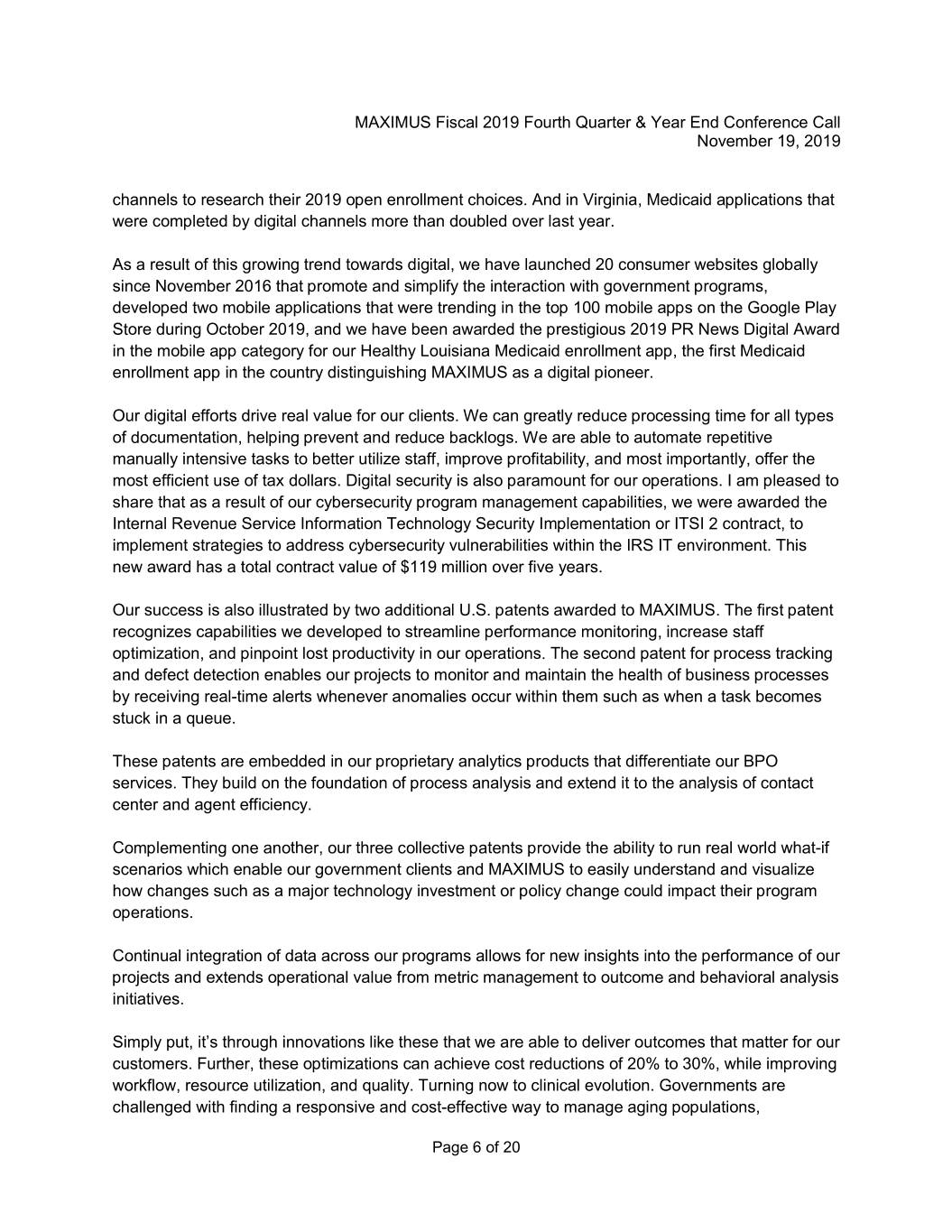
MAXIMUS Fiscal 2019 Fourth Quarter & Year End Conference Call November 19, 2019 channels to research their 2019 open enrollment choices. And in Virginia, Medicaid applications that were completed by digital channels more than doubled over last year. As a result of this growing trend towards digital, we have launched 20 consumer websites globally since November 2016 that promote and simplify the interaction with government programs, developed two mobile applications that were trending in the top 100 mobile apps on the Google Play Store during October 2019, and we have been awarded the prestigious 2019 PR News Digital Award in the mobile app category for our Healthy Louisiana Medicaid enrollment app, the first Medicaid enrollment app in the country distinguishing MAXIMUS as a digital pioneer. Our digital efforts drive real value for our clients. We can greatly reduce processing time for all types of documentation, helping prevent and reduce backlogs. We are able to automate repetitive manually intensive tasks to better utilize staff, improve profitability, and most importantly, offer the most efficient use of tax dollars. Digital security is also paramount for our operations. I am pleased to share that as a result of our cybersecurity program management capabilities, we were awarded the Internal Revenue Service Information Technology Security Implementation or ITSI 2 contract, to implement strategies to address cybersecurity vulnerabilities within the IRS IT environment. This new award has a total contract value of $119 million over five years. Our success is also illustrated by two additional U.S. patents awarded to MAXIMUS. The first patent recognizes capabilities we developed to streamline performance monitoring, increase staff optimization, and pinpoint lost productivity in our operations. The second patent for process tracking and defect detection enables our projects to monitor and maintain the health of business processes by receiving real-time alerts whenever anomalies occur within them such as when a task becomes stuck in a queue. These patents are embedded in our proprietary analytics products that differentiate our BPO services. They build on the foundation of process analysis and extend it to the analysis of contact center and agent efficiency. Complementing one another, our three collective patents provide the ability to run real world what-if scenarios which enable our government clients and MAXIMUS to easily understand and visualize how changes such as a major technology investment or policy change could impact their program operations. Continual integration of data across our programs allows for new insights into the performance of our projects and extends operational value from metric management to outcome and behavioral analysis initiatives. Simply put, it’s through innovations like these that we are able to deliver outcomes that matter for our customers. Further, these optimizations can achieve cost reductions of 20% to 30%, while improving workflow, resource utilization, and quality. Turning now to clinical evolution. Governments are challenged with finding a responsive and cost-effective way to manage aging populations, Page 6 of 20
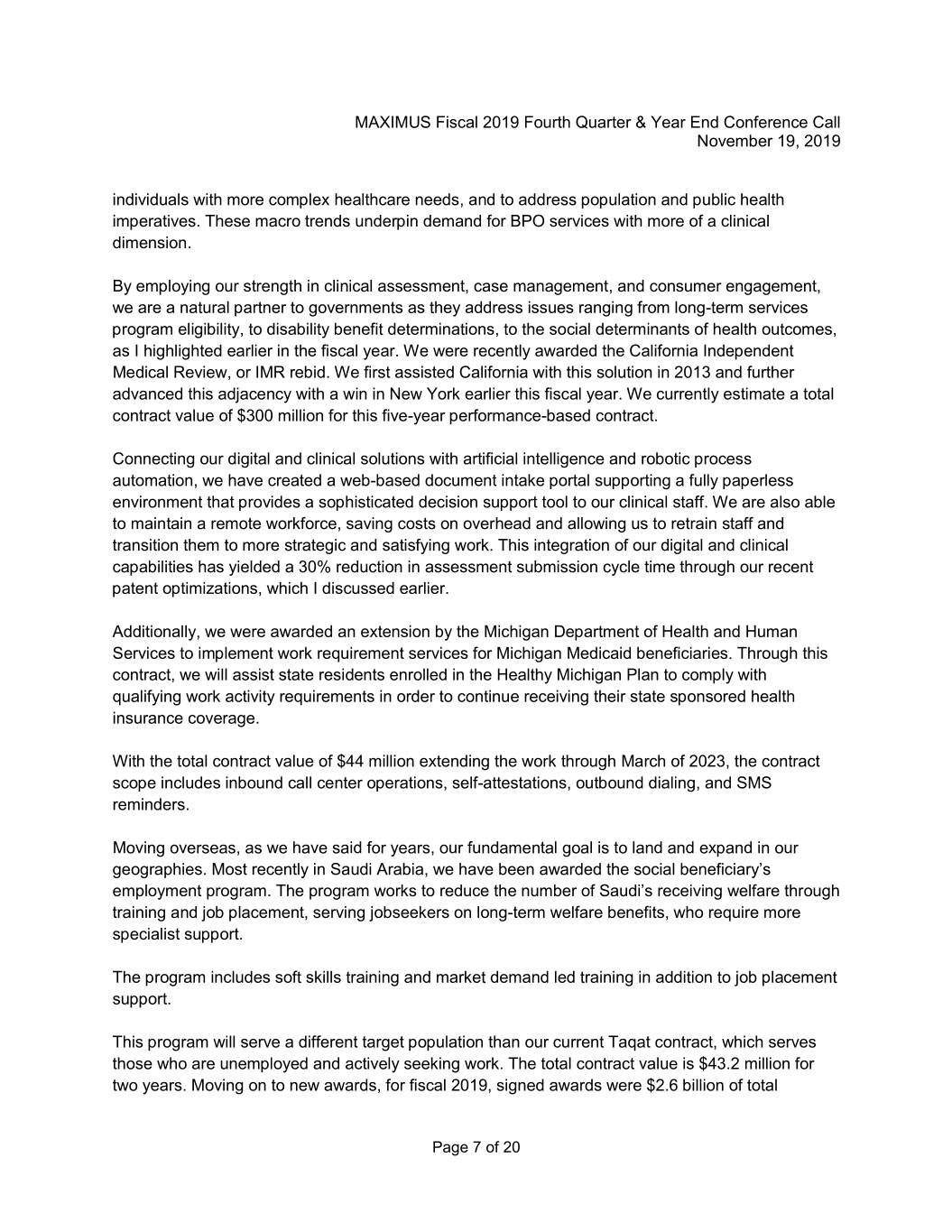
MAXIMUS Fiscal 2019 Fourth Quarter & Year End Conference Call November 19, 2019 individuals with more complex healthcare needs, and to address population and public health imperatives. These macro trends underpin demand for BPO services with more of a clinical dimension. By employing our strength in clinical assessment, case management, and consumer engagement, we are a natural partner to governments as they address issues ranging from long-term services program eligibility, to disability benefit determinations, to the social determinants of health outcomes, as I highlighted earlier in the fiscal year. We were recently awarded the California Independent Medical Review, or IMR rebid. We first assisted California with this solution in 2013 and further advanced this adjacency with a win in New York earlier this fiscal year. We currently estimate a total contract value of $300 million for this five-year performance-based contract. Connecting our digital and clinical solutions with artificial intelligence and robotic process automation, we have created a web-based document intake portal supporting a fully paperless environment that provides a sophisticated decision support tool to our clinical staff. We are also able to maintain a remote workforce, saving costs on overhead and allowing us to retrain staff and transition them to more strategic and satisfying work. This integration of our digital and clinical capabilities has yielded a 30% reduction in assessment submission cycle time through our recent patent optimizations, which I discussed earlier. Additionally, we were awarded an extension by the Michigan Department of Health and Human Services to implement work requirement services for Michigan Medicaid beneficiaries. Through this contract, we will assist state residents enrolled in the Healthy Michigan Plan to comply with qualifying work activity requirements in order to continue receiving their state sponsored health insurance coverage. With the total contract value of $44 million extending the work through March of 2023, the contract scope includes inbound call center operations, self-attestations, outbound dialing, and SMS reminders. Moving overseas, as we have said for years, our fundamental goal is to land and expand in our geographies. Most recently in Saudi Arabia, we have been awarded the social beneficiary’s employment program. The program works to reduce the number of Saudi’s receiving welfare through training and job placement, serving jobseekers on long-term welfare benefits, who require more specialist support. The program includes soft skills training and market demand led training in addition to job placement support. This program will serve a different target population than our current Taqat contract, which serves those who are unemployed and actively seeking work. The total contract value is $43.2 million for two years. Moving on to new awards, for fiscal 2019, signed awards were $2.6 billion of total Page 7 of 20
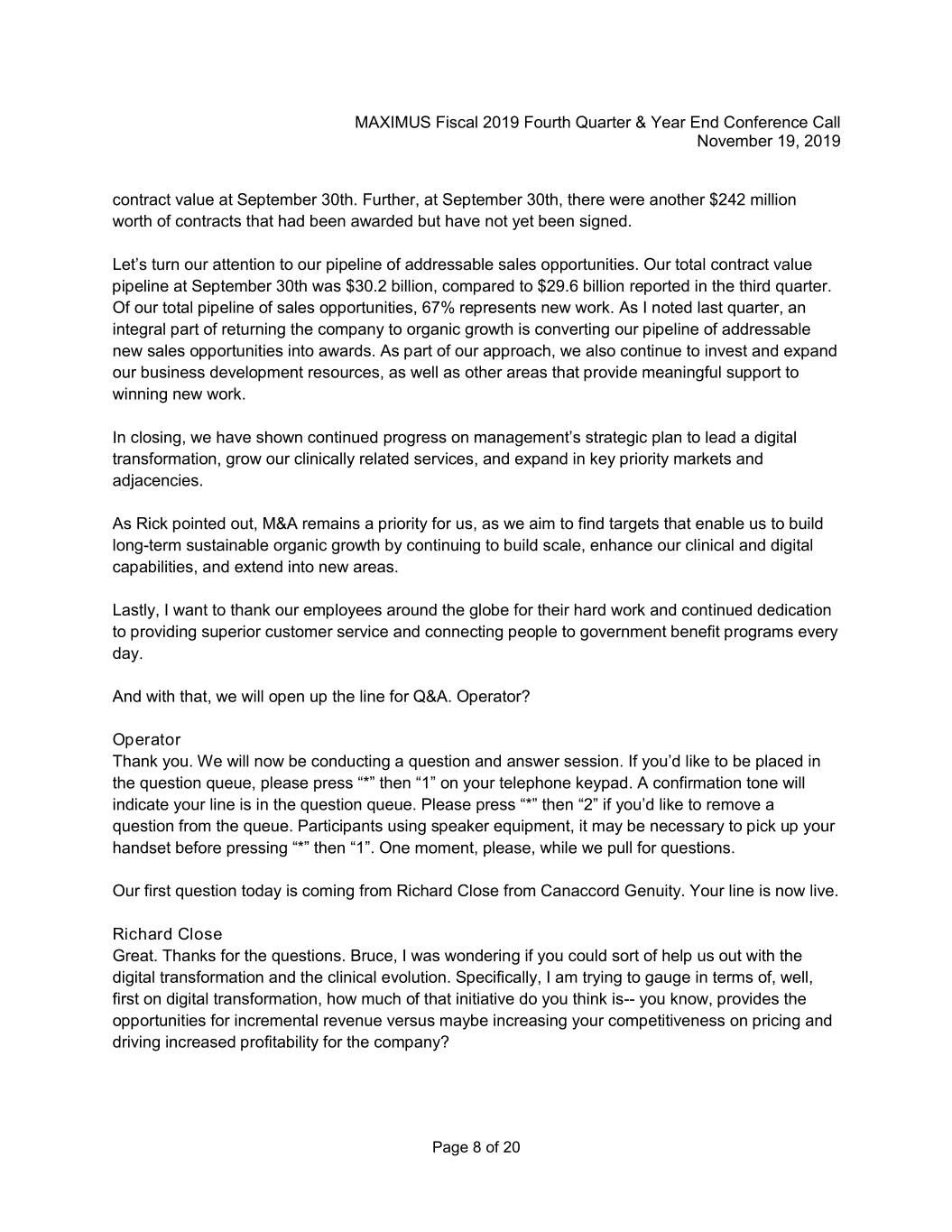
MAXIMUS Fiscal 2019 Fourth Quarter & Year End Conference Call November 19, 2019 contract value at September 30th. Further, at September 30th, there were another $242 million worth of contracts that had been awarded but have not yet been signed. Let’s turn our attention to our pipeline of addressable sales opportunities. Our total contract value pipeline at September 30th was $30.2 billion, compared to $29.6 billion reported in the third quarter. Of our total pipeline of sales opportunities, 67% represents new work. As I noted last quarter, an integral part of returning the company to organic growth is converting our pipeline of addressable new sales opportunities into awards. As part of our approach, we also continue to invest and expand our business development resources, as well as other areas that provide meaningful support to winning new work. In closing, we have shown continued progress on management’s strategic plan to lead a digital transformation, grow our clinically related services, and expand in key priority markets and adjacencies. As Rick pointed out, M&A remains a priority for us, as we aim to find targets that enable us to build long-term sustainable organic growth by continuing to build scale, enhance our clinical and digital capabilities, and extend into new areas. Lastly, I want to thank our employees around the globe for their hard work and continued dedication to providing superior customer service and connecting people to government benefit programs every day. And with that, we will open up the line for Q&A. Operator? Operator Thank you. We will now be conducting a question and answer session. If you’d like to be placed in the question queue, please press “*” then “1” on your telephone keypad. A confirmation tone will indicate your line is in the question queue. Please press “*” then “2” if you’d like to remove a question from the queue. Participants using speaker equipment, it may be necessary to pick up your handset before pressing “*” then “1”. One moment, please, while we pull for questions. Our first question today is coming from Richard Close from Canaccord Genuity. Your line is now live. Richard Close Great. Thanks for the questions. Bruce, I was wondering if you could sort of help us out with the digital transformation and the clinical evolution. Specifically, I am trying to gauge in terms of, well, first on digital transformation, how much of that initiative do you think is-- you know, provides the opportunities for incremental revenue versus maybe increasing your competitiveness on pricing and driving increased profitability for the company? Page 8 of 20
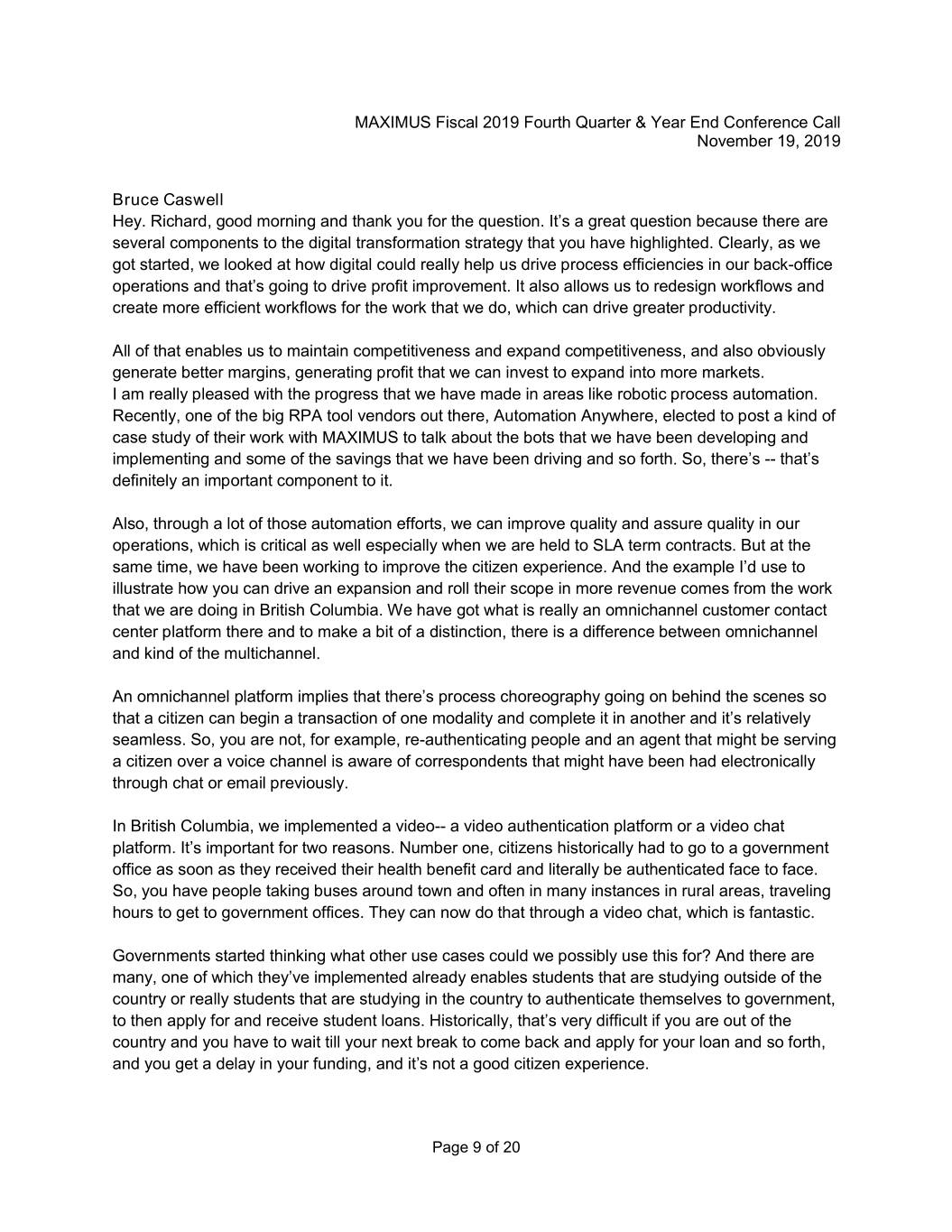
MAXIMUS Fiscal 2019 Fourth Quarter & Year End Conference Call November 19, 2019 Bruce Caswell Hey. Richard, good morning and thank you for the question. It’s a great question because there are several components to the digital transformation strategy that you have highlighted. Clearly, as we got started, we looked at how digital could really help us drive process efficiencies in our back-office operations and that’s going to drive profit improvement. It also allows us to redesign workflows and create more efficient workflows for the work that we do, which can drive greater productivity. All of that enables us to maintain competitiveness and expand competitiveness, and also obviously generate better margins, generating profit that we can invest to expand into more markets. I am really pleased with the progress that we have made in areas like robotic process automation. Recently, one of the big RPA tool vendors out there, Automation Anywhere, elected to post a kind of case study of their work with MAXIMUS to talk about the bots that we have been developing and implementing and some of the savings that we have been driving and so forth. So, there’s -- that’s definitely an important component to it. Also, through a lot of those automation efforts, we can improve quality and assure quality in our operations, which is critical as well especially when we are held to SLA term contracts. But at the same time, we have been working to improve the citizen experience. And the example I’d use to illustrate how you can drive an expansion and roll their scope in more revenue comes from the work that we are doing in British Columbia. We have got what is really an omnichannel customer contact center platform there and to make a bit of a distinction, there is a difference between omnichannel and kind of the multichannel. An omnichannel platform implies that there’s process choreography going on behind the scenes so that a citizen can begin a transaction of one modality and complete it in another and it’s relatively seamless. So, you are not, for example, re-authenticating people and an agent that might be serving a citizen over a voice channel is aware of correspondents that might have been had electronically through chat or email previously. In British Columbia, we implemented a video-- a video authentication platform or a video chat platform. It’s important for two reasons. Number one, citizens historically had to go to a government office as soon as they received their health benefit card and literally be authenticated face to face. So, you have people taking buses around town and often in many instances in rural areas, traveling hours to get to government offices. They can now do that through a video chat, which is fantastic. Governments started thinking what other use cases could we possibly use this for? And there are many, one of which they’ve implemented already enables students that are studying outside of the country or really students that are studying in the country to authenticate themselves to government, to then apply for and receive student loans. Historically, that’s very difficult if you are out of the country and you have to wait till your next break to come back and apply for your loan and so forth, and you get a delay in your funding, and it’s not a good citizen experience. Page 9 of 20
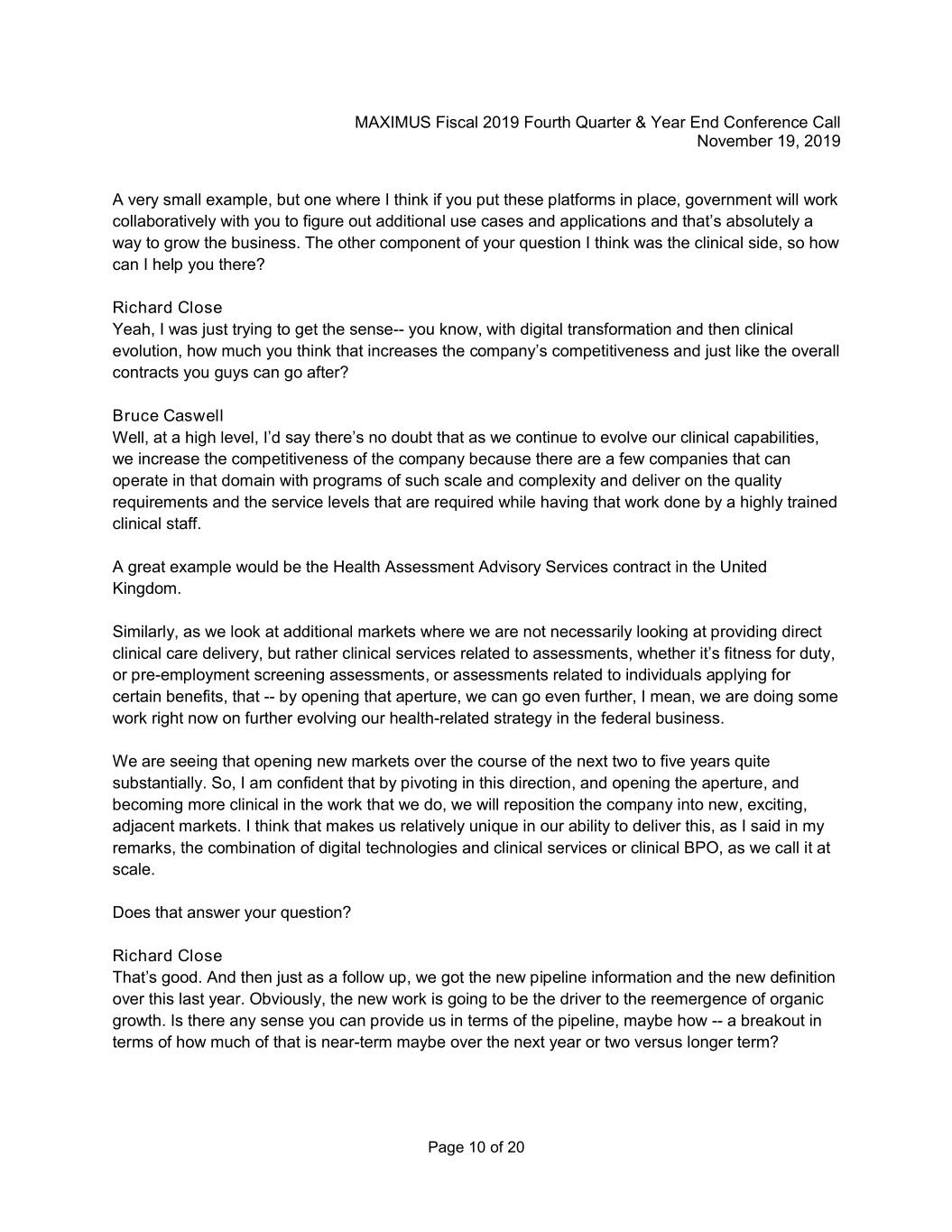
MAXIMUS Fiscal 2019 Fourth Quarter & Year End Conference Call November 19, 2019 A very small example, but one where I think if you put these platforms in place, government will work collaboratively with you to figure out additional use cases and applications and that’s absolutely a way to grow the business. The other component of your question I think was the clinical side, so how can I help you there? Richard Close Yeah, I was just trying to get the sense-- you know, with digital transformation and then clinical evolution, how much you think that increases the company’s competitiveness and just like the overall contracts you guys can go after? Bruce Caswell Well, at a high level, I’d say there’s no doubt that as we continue to evolve our clinical capabilities, we increase the competitiveness of the company because there are a few companies that can operate in that domain with programs of such scale and complexity and deliver on the quality requirements and the service levels that are required while having that work done by a highly trained clinical staff. A great example would be the Health Assessment Advisory Services contract in the United Kingdom. Similarly, as we look at additional markets where we are not necessarily looking at providing direct clinical care delivery, but rather clinical services related to assessments, whether it’s fitness for duty, or pre-employment screening assessments, or assessments related to individuals applying for certain benefits, that -- by opening that aperture, we can go even further, I mean, we are doing some work right now on further evolving our health-related strategy in the federal business. We are seeing that opening new markets over the course of the next two to five years quite substantially. So, I am confident that by pivoting in this direction, and opening the aperture, and becoming more clinical in the work that we do, we will reposition the company into new, exciting, adjacent markets. I think that makes us relatively unique in our ability to deliver this, as I said in my remarks, the combination of digital technologies and clinical services or clinical BPO, as we call it at scale. Does that answer your question? Richard Close That’s good. And then just as a follow up, we got the new pipeline information and the new definition over this last year. Obviously, the new work is going to be the driver to the reemergence of organic growth. Is there any sense you can provide us in terms of the pipeline, maybe how -- a breakout in terms of how much of that is near-term maybe over the next year or two versus longer term? Page 10 of 20
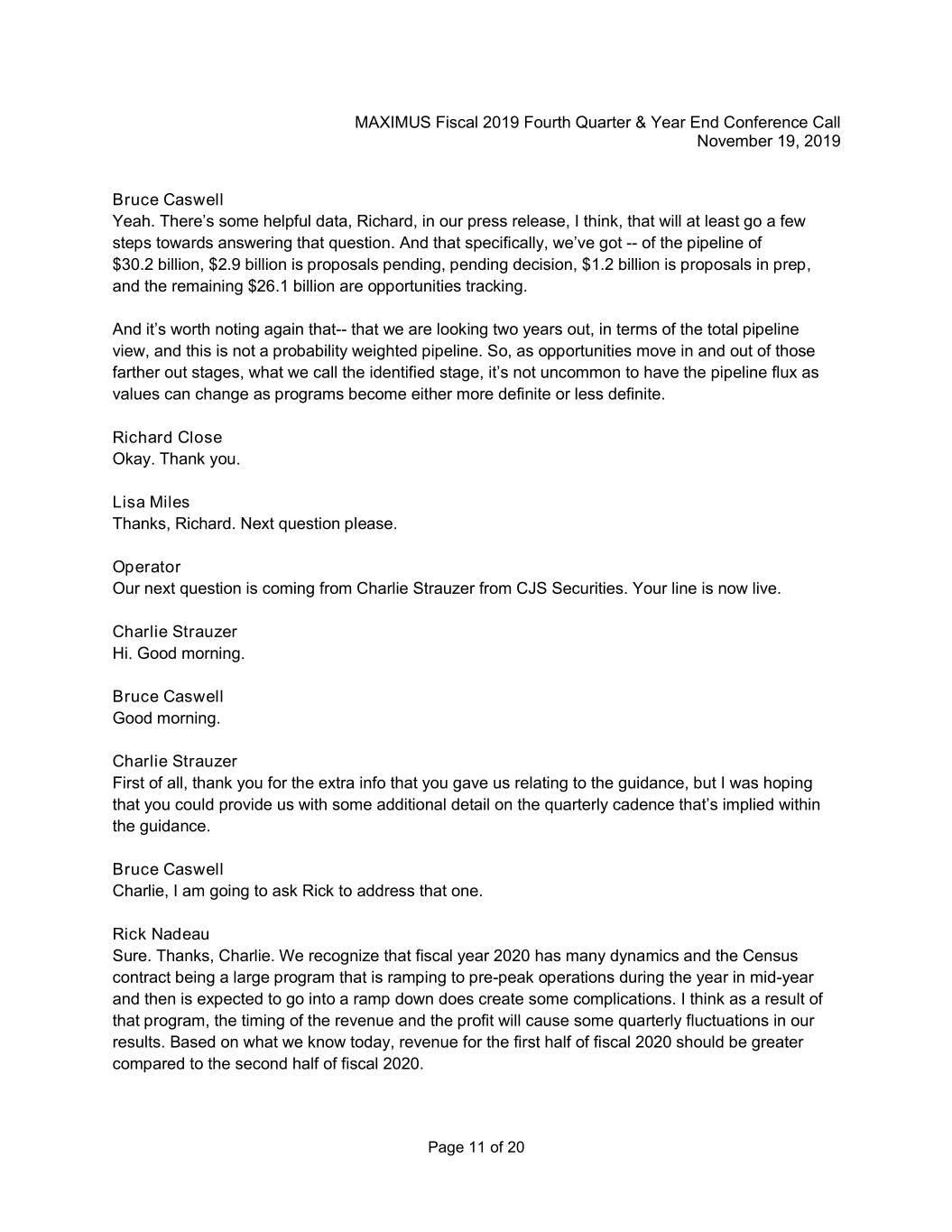
MAXIMUS Fiscal 2019 Fourth Quarter & Year End Conference Call November 19, 2019 Bruce Caswell Yeah. There’s some helpful data, Richard, in our press release, I think, that will at least go a few steps towards answering that question. And that specifically, we’ve got -- of the pipeline of $30.2 billion, $2.9 billion is proposals pending, pending decision, $1.2 billion is proposals in prep, and the remaining $26.1 billion are opportunities tracking. And it’s worth noting again that-- that we are looking two years out, in terms of the total pipeline view, and this is not a probability weighted pipeline. So, as opportunities move in and out of those farther out stages, what we call the identified stage, it’s not uncommon to have the pipeline flux as values can change as programs become either more definite or less definite. Richard Close Okay. Thank you. Lisa Miles Thanks, Richard. Next question please. Operator Our next question is coming from Charlie Strauzer from CJS Securities. Your line is now live. Charlie Strauzer Hi. Good morning. Bruce Caswell Good morning. Charlie Strauzer First of all, thank you for the extra info that you gave us relating to the guidance, but I was hoping that you could provide us with some additional detail on the quarterly cadence that’s implied within the guidance. Bruce Caswell Charlie, I am going to ask Rick to address that one. Rick Nadeau Sure. Thanks, Charlie. We recognize that fiscal year 2020 has many dynamics and the Census contract being a large program that is ramping to pre-peak operations during the year in mid-year and then is expected to go into a ramp down does create some complications. I think as a result of that program, the timing of the revenue and the profit will cause some quarterly fluctuations in our results. Based on what we know today, revenue for the first half of fiscal 2020 should be greater compared to the second half of fiscal 2020. Page 11 of 20
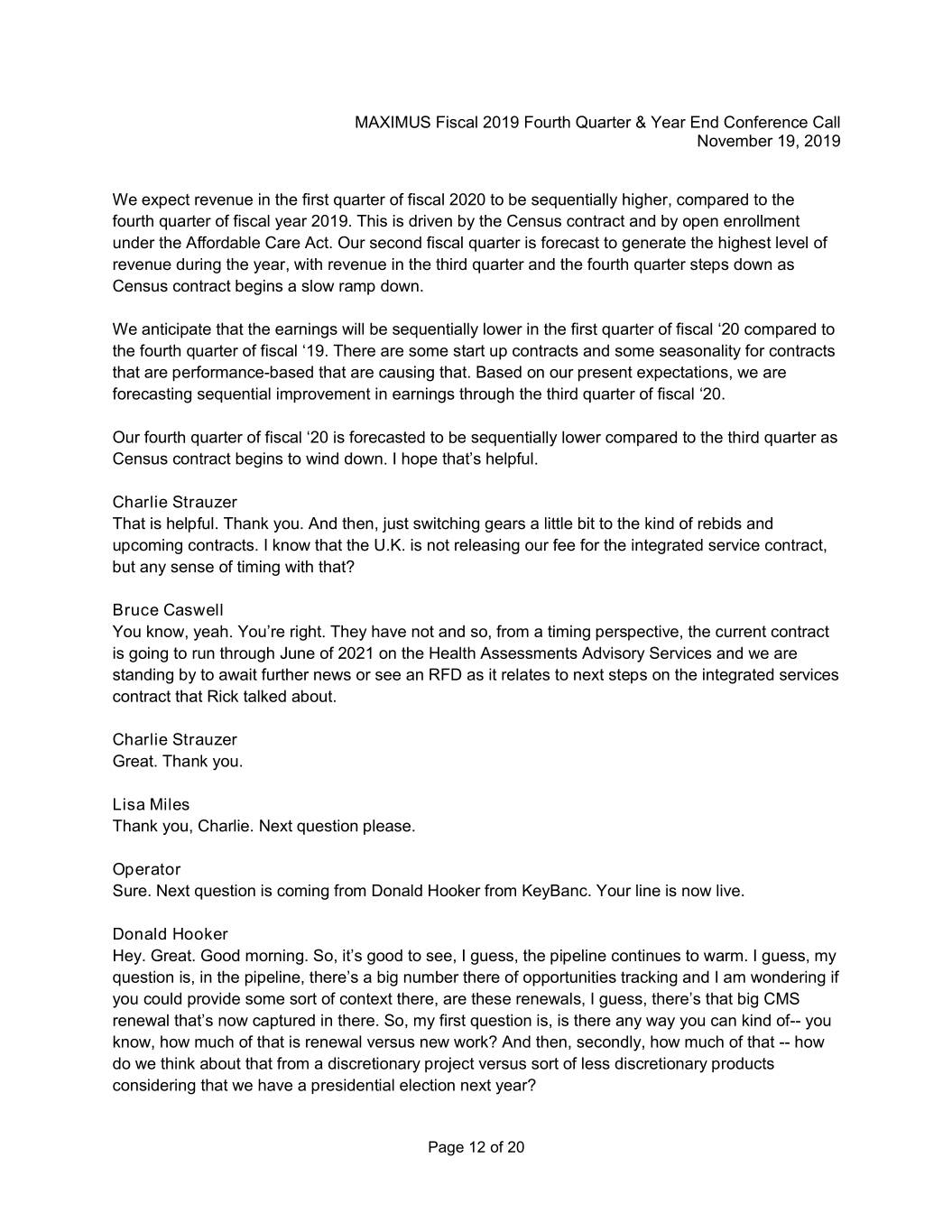
MAXIMUS Fiscal 2019 Fourth Quarter & Year End Conference Call November 19, 2019 We expect revenue in the first quarter of fiscal 2020 to be sequentially higher, compared to the fourth quarter of fiscal year 2019. This is driven by the Census contract and by open enrollment under the Affordable Care Act. Our second fiscal quarter is forecast to generate the highest level of revenue during the year, with revenue in the third quarter and the fourth quarter steps down as Census contract begins a slow ramp down. We anticipate that the earnings will be sequentially lower in the first quarter of fiscal ‘20 compared to the fourth quarter of fiscal ‘19. There are some start up contracts and some seasonality for contracts that are performance-based that are causing that. Based on our present expectations, we are forecasting sequential improvement in earnings through the third quarter of fiscal ‘20. Our fourth quarter of fiscal ‘20 is forecasted to be sequentially lower compared to the third quarter as Census contract begins to wind down. I hope that’s helpful. Charlie Strauzer That is helpful. Thank you. And then, just switching gears a little bit to the kind of rebids and upcoming contracts. I know that the U.K. is not releasing our fee for the integrated service contract, but any sense of timing with that? Bruce Caswell You know, yeah. You’re right. They have not and so, from a timing perspective, the current contract is going to run through June of 2021 on the Health Assessments Advisory Services and we are standing by to await further news or see an RFD as it relates to next steps on the integrated services contract that Rick talked about. Charlie Strauzer Great. Thank you. Lisa Miles Thank you, Charlie. Next question please. Operator Sure. Next question is coming from Donald Hooker from KeyBanc. Your line is now live. Donald Hooker Hey. Great. Good morning. So, it’s good to see, I guess, the pipeline continues to warm. I guess, my question is, in the pipeline, there’s a big number there of opportunities tracking and I am wondering if you could provide some sort of context there, are these renewals, I guess, there’s that big CMS renewal that’s now captured in there. So, my first question is, is there any way you can kind of-- you know, how much of that is renewal versus new work? And then, secondly, how much of that -- how do we think about that from a discretionary project versus sort of less discretionary products considering that we have a presidential election next year? Page 12 of 20
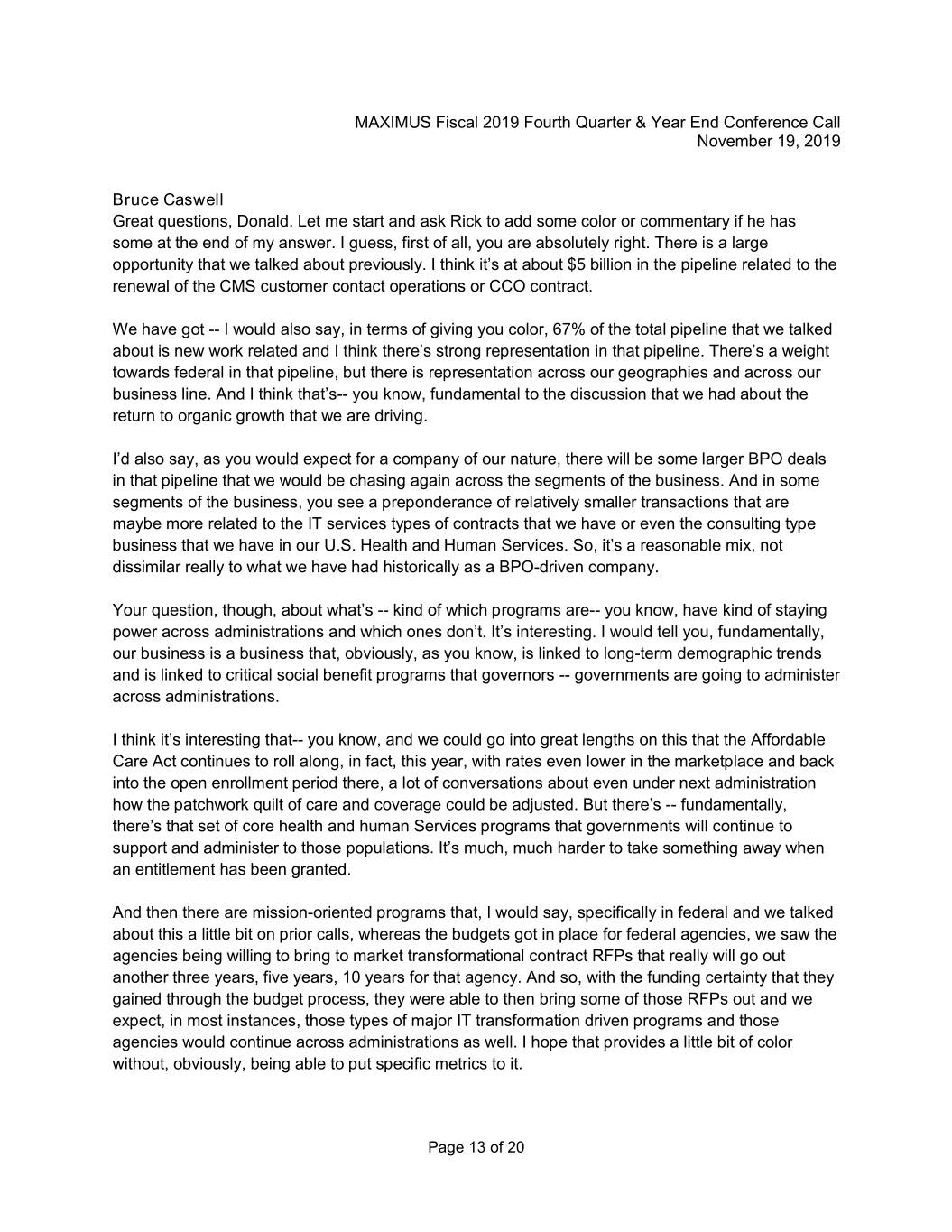
MAXIMUS Fiscal 2019 Fourth Quarter & Year End Conference Call November 19, 2019 Bruce Caswell Great questions, Donald. Let me start and ask Rick to add some color or commentary if he has some at the end of my answer. I guess, first of all, you are absolutely right. There is a large opportunity that we talked about previously. I think it’s at about $5 billion in the pipeline related to the renewal of the CMS customer contact operations or CCO contract. We have got -- I would also say, in terms of giving you color, 67% of the total pipeline that we talked about is new work related and I think there’s strong representation in that pipeline. There’s a weight towards federal in that pipeline, but there is representation across our geographies and across our business line. And I think that’s-- you know, fundamental to the discussion that we had about the return to organic growth that we are driving. I’d also say, as you would expect for a company of our nature, there will be some larger BPO deals in that pipeline that we would be chasing again across the segments of the business. And in some segments of the business, you see a preponderance of relatively smaller transactions that are maybe more related to the IT services types of contracts that we have or even the consulting type business that we have in our U.S. Health and Human Services. So, it’s a reasonable mix, not dissimilar really to what we have had historically as a BPO-driven company. Your question, though, about what’s -- kind of which programs are-- you know, have kind of staying power across administrations and which ones don’t. It’s interesting. I would tell you, fundamentally, our business is a business that, obviously, as you know, is linked to long-term demographic trends and is linked to critical social benefit programs that governors -- governments are going to administer across administrations. I think it’s interesting that-- you know, and we could go into great lengths on this that the Affordable Care Act continues to roll along, in fact, this year, with rates even lower in the marketplace and back into the open enrollment period there, a lot of conversations about even under next administration how the patchwork quilt of care and coverage could be adjusted. But there’s -- fundamentally, there’s that set of core health and human Services programs that governments will continue to support and administer to those populations. It’s much, much harder to take something away when an entitlement has been granted. And then there are mission-oriented programs that, I would say, specifically in federal and we talked about this a little bit on prior calls, whereas the budgets got in place for federal agencies, we saw the agencies being willing to bring to market transformational contract RFPs that really will go out another three years, five years, 10 years for that agency. And so, with the funding certainty that they gained through the budget process, they were able to then bring some of those RFPs out and we expect, in most instances, those types of major IT transformation driven programs and those agencies would continue across administrations as well. I hope that provides a little bit of color without, obviously, being able to put specific metrics to it. Page 13 of 20
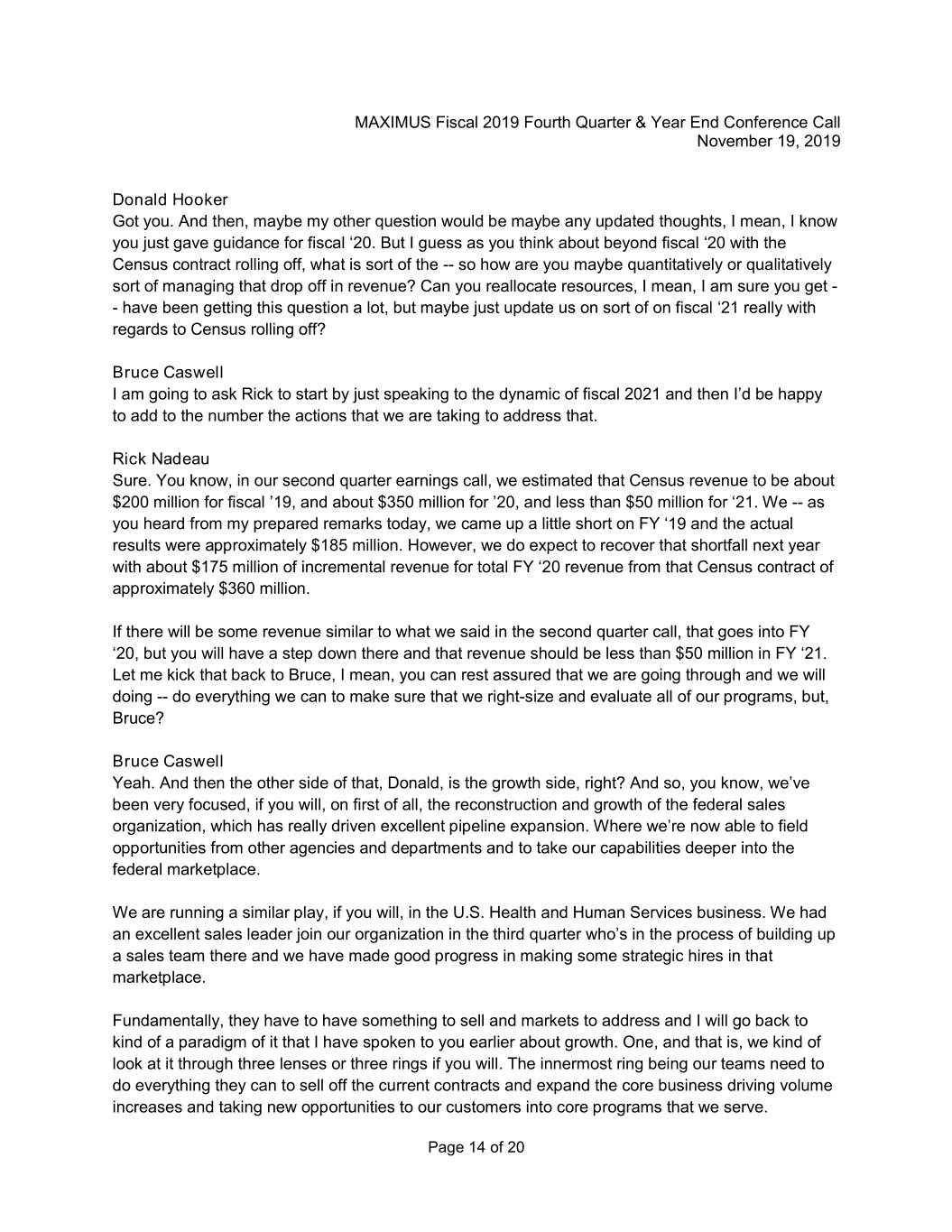
MAXIMUS Fiscal 2019 Fourth Quarter & Year End Conference Call November 19, 2019 Donald Hooker Got you. And then, maybe my other question would be maybe any updated thoughts, I mean, I know you just gave guidance for fiscal ‘20. But I guess as you think about beyond fiscal ‘20 with the Census contract rolling off, what is sort of the -- so how are you maybe quantitatively or qualitatively sort of managing that drop off in revenue? Can you reallocate resources, I mean, I am sure you get - - have been getting this question a lot, but maybe just update us on sort of on fiscal ‘21 really with regards to Census rolling off? Bruce Caswell I am going to ask Rick to start by just speaking to the dynamic of fiscal 2021 and then I’d be happy to add to the number the actions that we are taking to address that. Rick Nadeau Sure. You know, in our second quarter earnings call, we estimated that Census revenue to be about $200 million for fiscal ’19, and about $350 million for ’20, and less than $50 million for ‘21. We -- as you heard from my prepared remarks today, we came up a little short on FY ‘19 and the actual results were approximately $185 million. However, we do expect to recover that shortfall next year with about $175 million of incremental revenue for total FY ‘20 revenue from that Census contract of approximately $360 million. If there will be some revenue similar to what we said in the second quarter call, that goes into FY ‘20, but you will have a step down there and that revenue should be less than $50 million in FY ‘21. Let me kick that back to Bruce, I mean, you can rest assured that we are going through and we will doing -- do everything we can to make sure that we right-size and evaluate all of our programs, but, Bruce? Bruce Caswell Yeah. And then the other side of that, Donald, is the growth side, right? And so, you know, we’ve been very focused, if you will, on first of all, the reconstruction and growth of the federal sales organization, which has really driven excellent pipeline expansion. Where we’re now able to field opportunities from other agencies and departments and to take our capabilities deeper into the federal marketplace. We are running a similar play, if you will, in the U.S. Health and Human Services business. We had an excellent sales leader join our organization in the third quarter who’s in the process of building up a sales team there and we have made good progress in making some strategic hires in that marketplace. Fundamentally, they have to have something to sell and markets to address and I will go back to kind of a paradigm of it that I have spoken to you earlier about growth. One, and that is, we kind of look at it through three lenses or three rings if you will. The innermost ring being our teams need to do everything they can to sell off the current contracts and expand the core business driving volume increases and taking new opportunities to our customers into core programs that we serve. Page 14 of 20
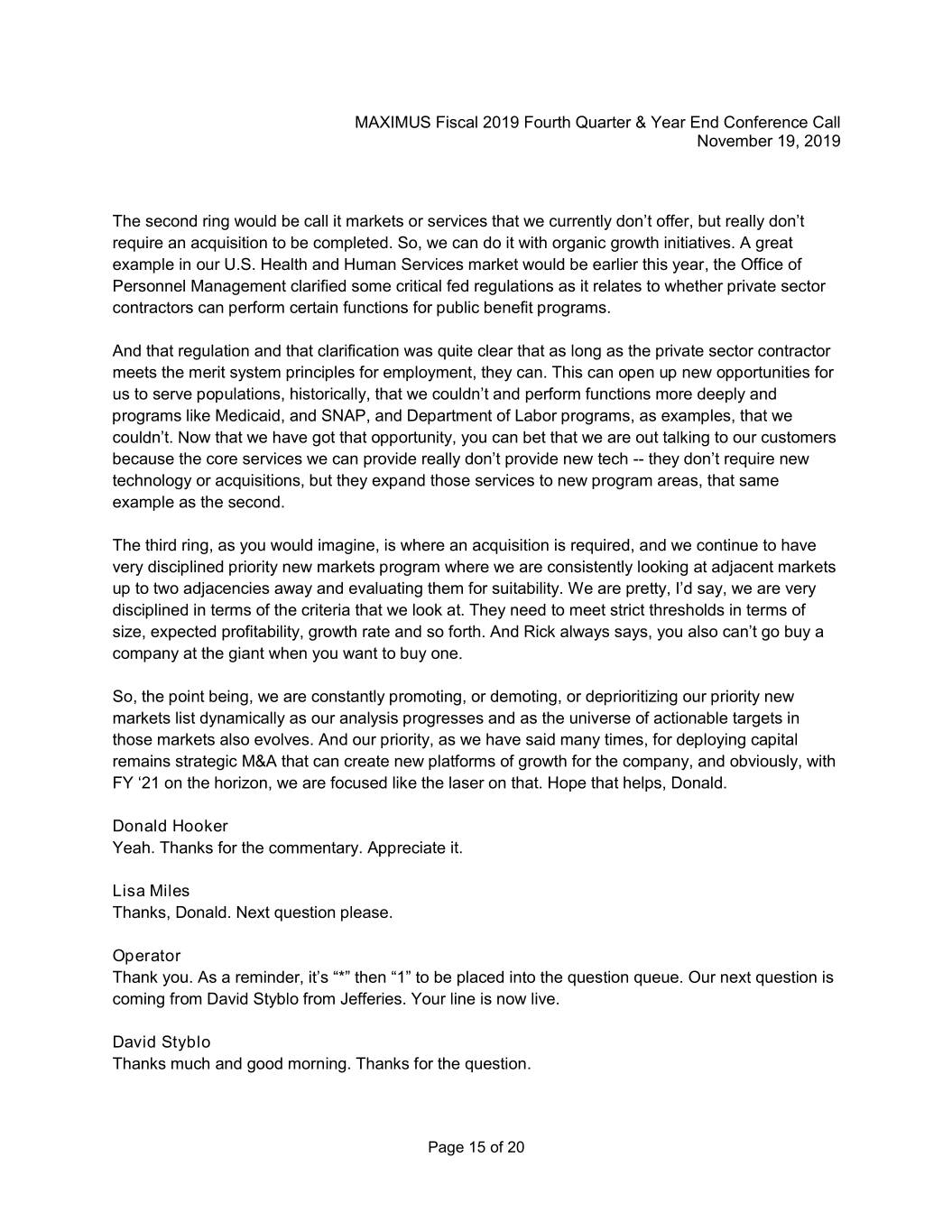
MAXIMUS Fiscal 2019 Fourth Quarter & Year End Conference Call November 19, 2019 The second ring would be call it markets or services that we currently don’t offer, but really don’t require an acquisition to be completed. So, we can do it with organic growth initiatives. A great example in our U.S. Health and Human Services market would be earlier this year, the Office of Personnel Management clarified some critical fed regulations as it relates to whether private sector contractors can perform certain functions for public benefit programs. And that regulation and that clarification was quite clear that as long as the private sector contractor meets the merit system principles for employment, they can. This can open up new opportunities for us to serve populations, historically, that we couldn’t and perform functions more deeply and programs like Medicaid, and SNAP, and Department of Labor programs, as examples, that we couldn’t. Now that we have got that opportunity, you can bet that we are out talking to our customers because the core services we can provide really don’t provide new tech -- they don’t require new technology or acquisitions, but they expand those services to new program areas, that same example as the second. The third ring, as you would imagine, is where an acquisition is required, and we continue to have very disciplined priority new markets program where we are consistently looking at adjacent markets up to two adjacencies away and evaluating them for suitability. We are pretty, I’d say, we are very disciplined in terms of the criteria that we look at. They need to meet strict thresholds in terms of size, expected profitability, growth rate and so forth. And Rick always says, you also can’t go buy a company at the giant when you want to buy one. So, the point being, we are constantly promoting, or demoting, or deprioritizing our priority new markets list dynamically as our analysis progresses and as the universe of actionable targets in those markets also evolves. And our priority, as we have said many times, for deploying capital remains strategic M&A that can create new platforms of growth for the company, and obviously, with FY ‘21 on the horizon, we are focused like the laser on that. Hope that helps, Donald. Donald Hooker Yeah. Thanks for the commentary. Appreciate it. Lisa Miles Thanks, Donald. Next question please. Operator Thank you. As a reminder, it’s “*” then “1” to be placed into the question queue. Our next question is coming from David Styblo from Jefferies. Your line is now live. David Styblo Thanks much and good morning. Thanks for the question. Page 15 of 20
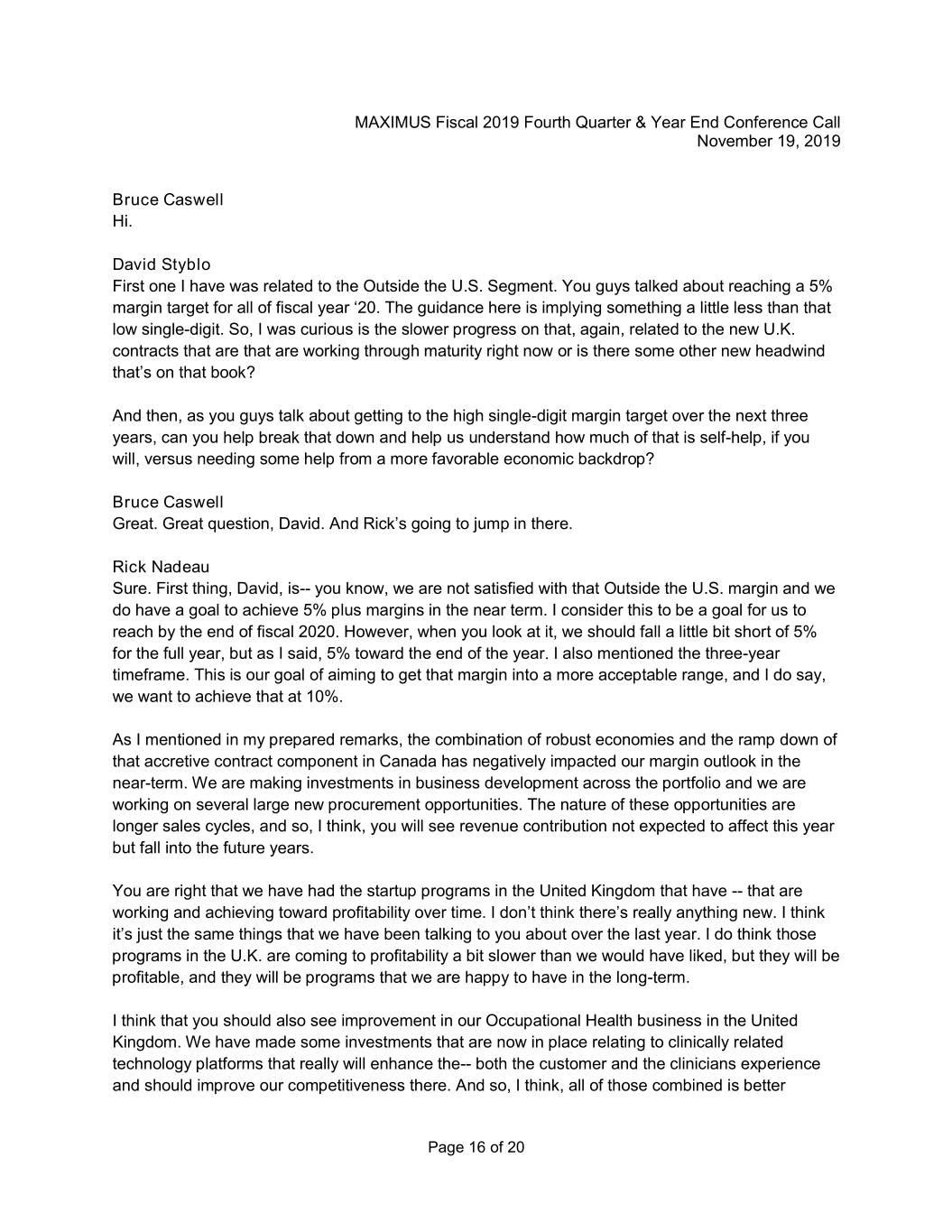
MAXIMUS Fiscal 2019 Fourth Quarter & Year End Conference Call November 19, 2019 Bruce Caswell Hi. David Styblo First one I have was related to the Outside the U.S. Segment. You guys talked about reaching a 5% margin target for all of fiscal year ‘20. The guidance here is implying something a little less than that low single-digit. So, I was curious is the slower progress on that, again, related to the new U.K. contracts that are that are working through maturity right now or is there some other new headwind that’s on that book? And then, as you guys talk about getting to the high single-digit margin target over the next three years, can you help break that down and help us understand how much of that is self-help, if you will, versus needing some help from a more favorable economic backdrop? Bruce Caswell Great. Great question, David. And Rick’s going to jump in there. Rick Nadeau Sure. First thing, David, is-- you know, we are not satisfied with that Outside the U.S. margin and we do have a goal to achieve 5% plus margins in the near term. I consider this to be a goal for us to reach by the end of fiscal 2020. However, when you look at it, we should fall a little bit short of 5% for the full year, but as I said, 5% toward the end of the year. I also mentioned the three-year timeframe. This is our goal of aiming to get that margin into a more acceptable range, and I do say, we want to achieve that at 10%. As I mentioned in my prepared remarks, the combination of robust economies and the ramp down of that accretive contract component in Canada has negatively impacted our margin outlook in the near-term. We are making investments in business development across the portfolio and we are working on several large new procurement opportunities. The nature of these opportunities are longer sales cycles, and so, I think, you will see revenue contribution not expected to affect this year but fall into the future years. You are right that we have had the startup programs in the United Kingdom that have -- that are working and achieving toward profitability over time. I don’t think there’s really anything new. I think it’s just the same things that we have been talking to you about over the last year. I do think those programs in the U.K. are coming to profitability a bit slower than we would have liked, but they will be profitable, and they will be programs that we are happy to have in the long-term. I think that you should also see improvement in our Occupational Health business in the United Kingdom. We have made some investments that are now in place relating to clinically related technology platforms that really will enhance the-- both the customer and the clinicians experience and should improve our competitiveness there. And so, I think, all of those combined is better Page 16 of 20
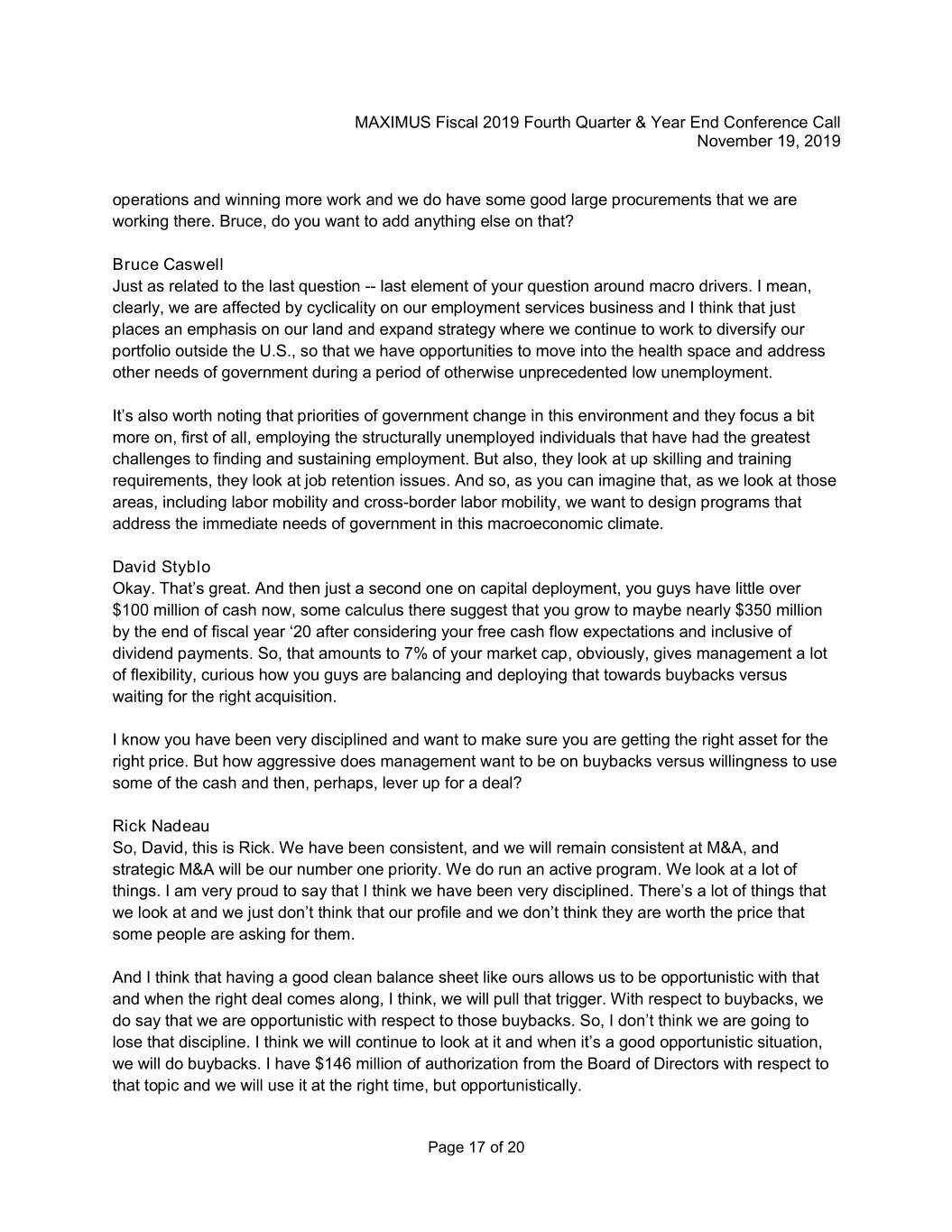
MAXIMUS Fiscal 2019 Fourth Quarter & Year End Conference Call November 19, 2019 operations and winning more work and we do have some good large procurements that we are working there. Bruce, do you want to add anything else on that? Bruce Caswell Just as related to the last question -- last element of your question around macro drivers. I mean, clearly, we are affected by cyclicality on our employment services business and I think that just places an emphasis on our land and expand strategy where we continue to work to diversify our portfolio outside the U.S., so that we have opportunities to move into the health space and address other needs of government during a period of otherwise unprecedented low unemployment. It’s also worth noting that priorities of government change in this environment and they focus a bit more on, first of all, employing the structurally unemployed individuals that have had the greatest challenges to finding and sustaining employment. But also, they look at up skilling and training requirements, they look at job retention issues. And so, as you can imagine that, as we look at those areas, including labor mobility and cross-border labor mobility, we want to design programs that address the immediate needs of government in this macroeconomic climate. David Styblo Okay. That’s great. And then just a second one on capital deployment, you guys have little over $100 million of cash now, some calculus there suggest that you grow to maybe nearly $350 million by the end of fiscal year ‘20 after considering your free cash flow expectations and inclusive of dividend payments. So, that amounts to 7% of your market cap, obviously, gives management a lot of flexibility, curious how you guys are balancing and deploying that towards buybacks versus waiting for the right acquisition. I know you have been very disciplined and want to make sure you are getting the right asset for the right price. But how aggressive does management want to be on buybacks versus willingness to use some of the cash and then, perhaps, lever up for a deal? Rick Nadeau So, David, this is Rick. We have been consistent, and we will remain consistent at M&A, and strategic M&A will be our number one priority. We do run an active program. We look at a lot of things. I am very proud to say that I think we have been very disciplined. There’s a lot of things that we look at and we just don’t think that our profile and we don’t think they are worth the price that some people are asking for them. And I think that having a good clean balance sheet like ours allows us to be opportunistic with that and when the right deal comes along, I think, we will pull that trigger. With respect to buybacks, we do say that we are opportunistic with respect to those buybacks. So, I don’t think we are going to lose that discipline. I think we will continue to look at it and when it’s a good opportunistic situation, we will do buybacks. I have $146 million of authorization from the Board of Directors with respect to that topic and we will use it at the right time, but opportunistically. Page 17 of 20
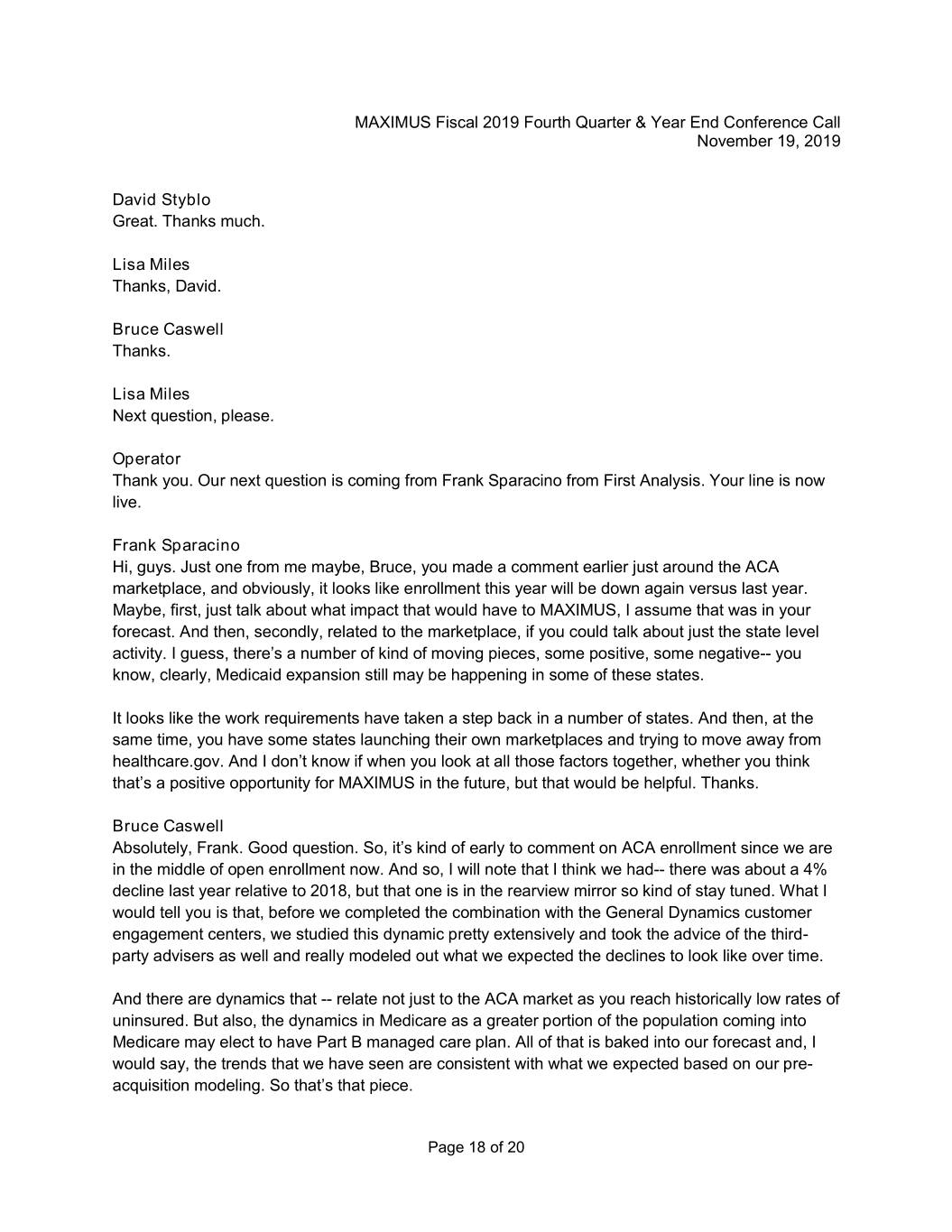
MAXIMUS Fiscal 2019 Fourth Quarter & Year End Conference Call November 19, 2019 David Styblo Great. Thanks much. Lisa Miles Thanks, David. Bruce Caswell Thanks. Lisa Miles Next question, please. Operator Thank you. Our next question is coming from Frank Sparacino from First Analysis. Your line is now live. Frank Sparacino Hi, guys. Just one from me maybe, Bruce, you made a comment earlier just around the ACA marketplace, and obviously, it looks like enrollment this year will be down again versus last year. Maybe, first, just talk about what impact that would have to MAXIMUS, I assume that was in your forecast. And then, secondly, related to the marketplace, if you could talk about just the state level activity. I guess, there’s a number of kind of moving pieces, some positive, some negative-- you know, clearly, Medicaid expansion still may be happening in some of these states. It looks like the work requirements have taken a step back in a number of states. And then, at the same time, you have some states launching their own marketplaces and trying to move away from healthcare.gov. And I don’t know if when you look at all those factors together, whether you think that’s a positive opportunity for MAXIMUS in the future, but that would be helpful. Thanks. Bruce Caswell Absolutely, Frank. Good question. So, it’s kind of early to comment on ACA enrollment since we are in the middle of open enrollment now. And so, I will note that I think we had-- there was about a 4% decline last year relative to 2018, but that one is in the rearview mirror so kind of stay tuned. What I would tell you is that, before we completed the combination with the General Dynamics customer engagement centers, we studied this dynamic pretty extensively and took the advice of the third- party advisers as well and really modeled out what we expected the declines to look like over time. And there are dynamics that -- relate not just to the ACA market as you reach historically low rates of uninsured. But also, the dynamics in Medicare as a greater portion of the population coming into Medicare may elect to have Part B managed care plan. All of that is baked into our forecast and, I would say, the trends that we have seen are consistent with what we expected based on our pre- acquisition modeling. So that’s that piece. Page 18 of 20
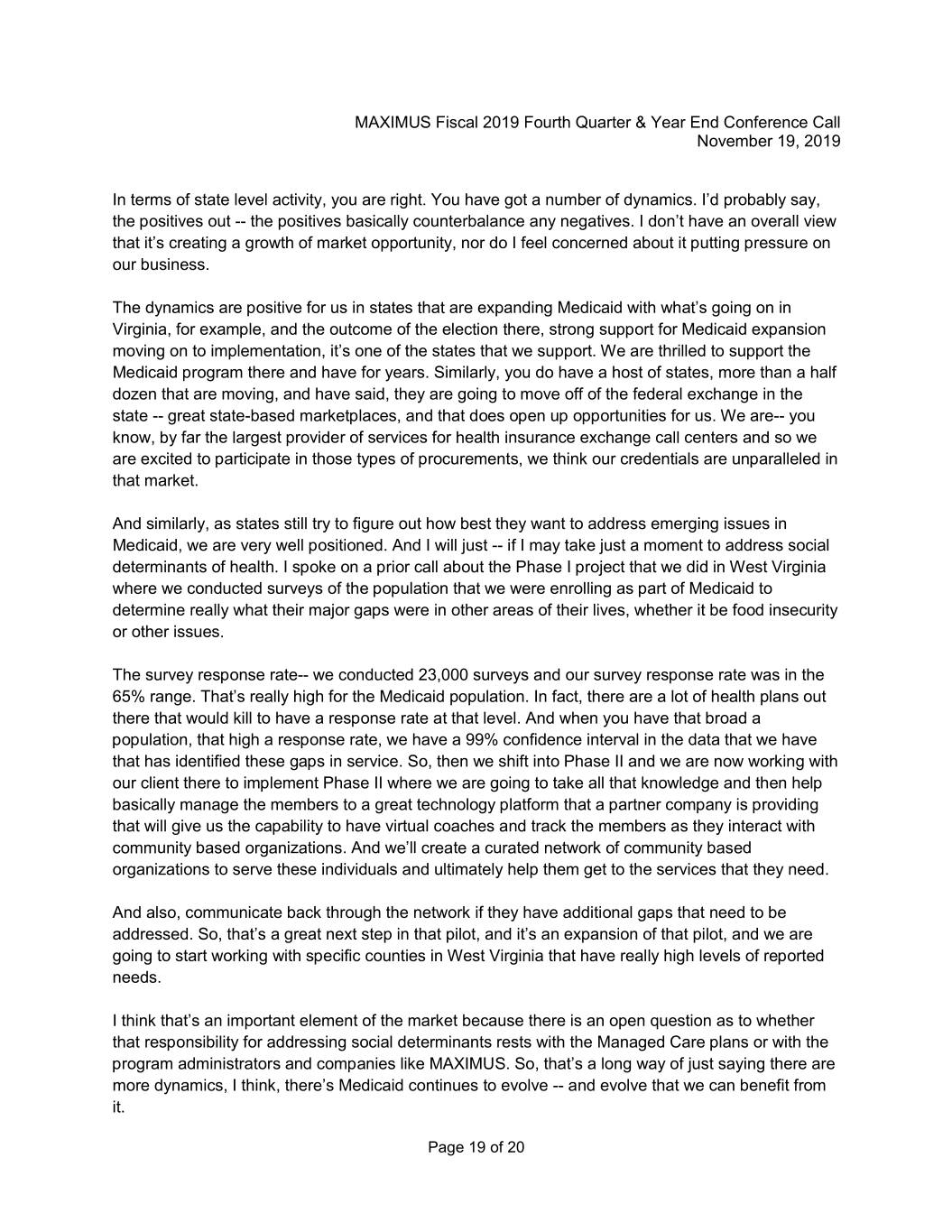
MAXIMUS Fiscal 2019 Fourth Quarter & Year End Conference Call November 19, 2019 In terms of state level activity, you are right. You have got a number of dynamics. I’d probably say, the positives out -- the positives basically counterbalance any negatives. I don’t have an overall view that it’s creating a growth of market opportunity, nor do I feel concerned about it putting pressure on our business. The dynamics are positive for us in states that are expanding Medicaid with what’s going on in Virginia, for example, and the outcome of the election there, strong support for Medicaid expansion moving on to implementation, it’s one of the states that we support. We are thrilled to support the Medicaid program there and have for years. Similarly, you do have a host of states, more than a half dozen that are moving, and have said, they are going to move off of the federal exchange in the state -- great state-based marketplaces, and that does open up opportunities for us. We are-- you know, by far the largest provider of services for health insurance exchange call centers and so we are excited to participate in those types of procurements, we think our credentials are unparalleled in that market. And similarly, as states still try to figure out how best they want to address emerging issues in Medicaid, we are very well positioned. And I will just -- if I may take just a moment to address social determinants of health. I spoke on a prior call about the Phase I project that we did in West Virginia where we conducted surveys of the population that we were enrolling as part of Medicaid to determine really what their major gaps were in other areas of their lives, whether it be food insecurity or other issues. The survey response rate-- we conducted 23,000 surveys and our survey response rate was in the 65% range. That’s really high for the Medicaid population. In fact, there are a lot of health plans out there that would kill to have a response rate at that level. And when you have that broad a population, that high a response rate, we have a 99% confidence interval in the data that we have that has identified these gaps in service. So, then we shift into Phase II and we are now working with our client there to implement Phase II where we are going to take all that knowledge and then help basically manage the members to a great technology platform that a partner company is providing that will give us the capability to have virtual coaches and track the members as they interact with community based organizations. And we’ll create a curated network of community based organizations to serve these individuals and ultimately help them get to the services that they need. And also, communicate back through the network if they have additional gaps that need to be addressed. So, that’s a great next step in that pilot, and it’s an expansion of that pilot, and we are going to start working with specific counties in West Virginia that have really high levels of reported needs. I think that’s an important element of the market because there is an open question as to whether that responsibility for addressing social determinants rests with the Managed Care plans or with the program administrators and companies like MAXIMUS. So, that’s a long way of just saying there are more dynamics, I think, there’s Medicaid continues to evolve -- and evolve that we can benefit from it. Page 19 of 20
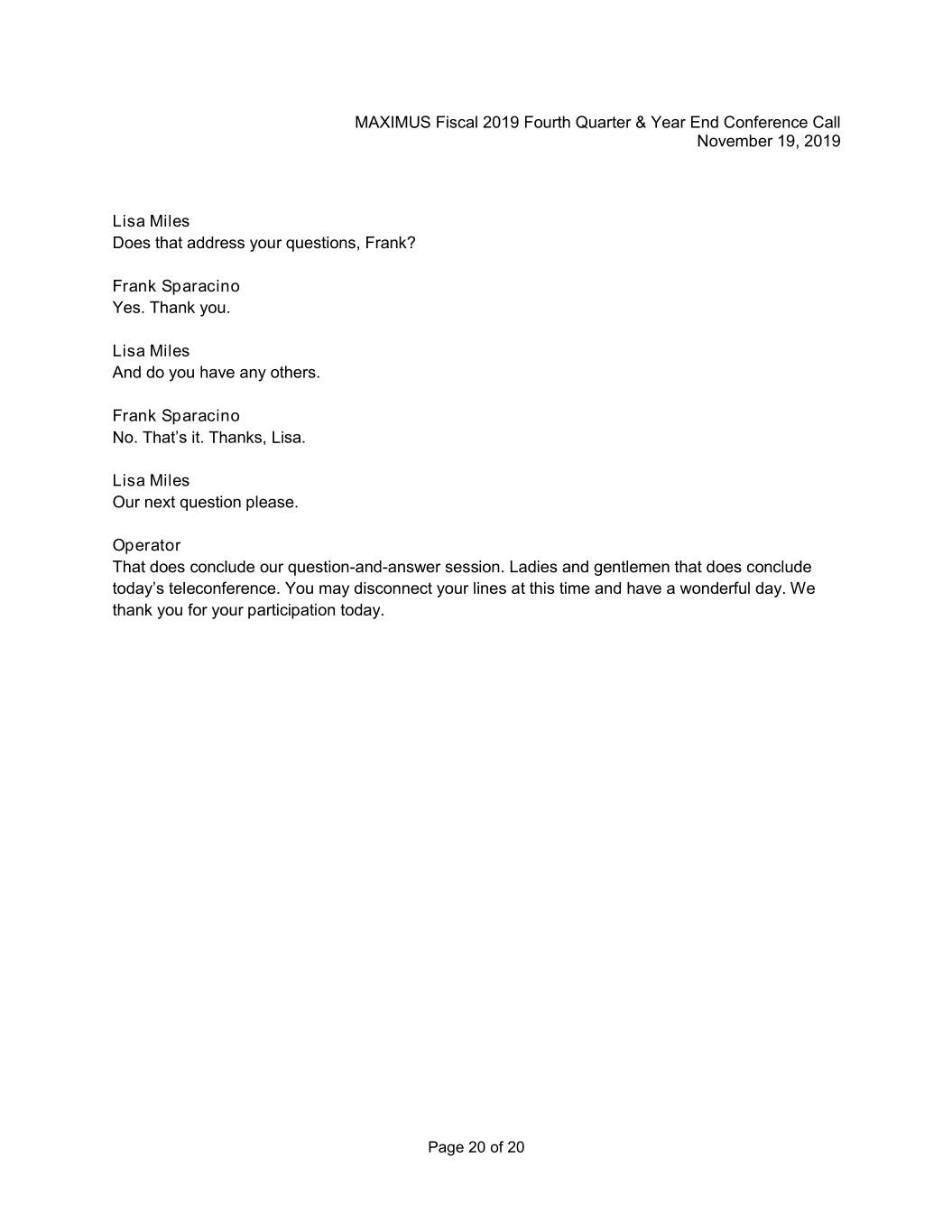
MAXIMUS Fiscal 2019 Fourth Quarter & Year End Conference Call November 19, 2019 Lisa Miles Does that address your questions, Frank? Frank Sparacino Yes. Thank you. Lisa Miles And do you have any others. Frank Sparacino No. That’s it. Thanks, Lisa. Lisa Miles Our next question please. Operator That does conclude our question-and-answer session. Ladies and gentlemen that does conclude today’s teleconference. You may disconnect your lines at this time and have a wonderful day. We thank you for your participation today. Page 20 of 20